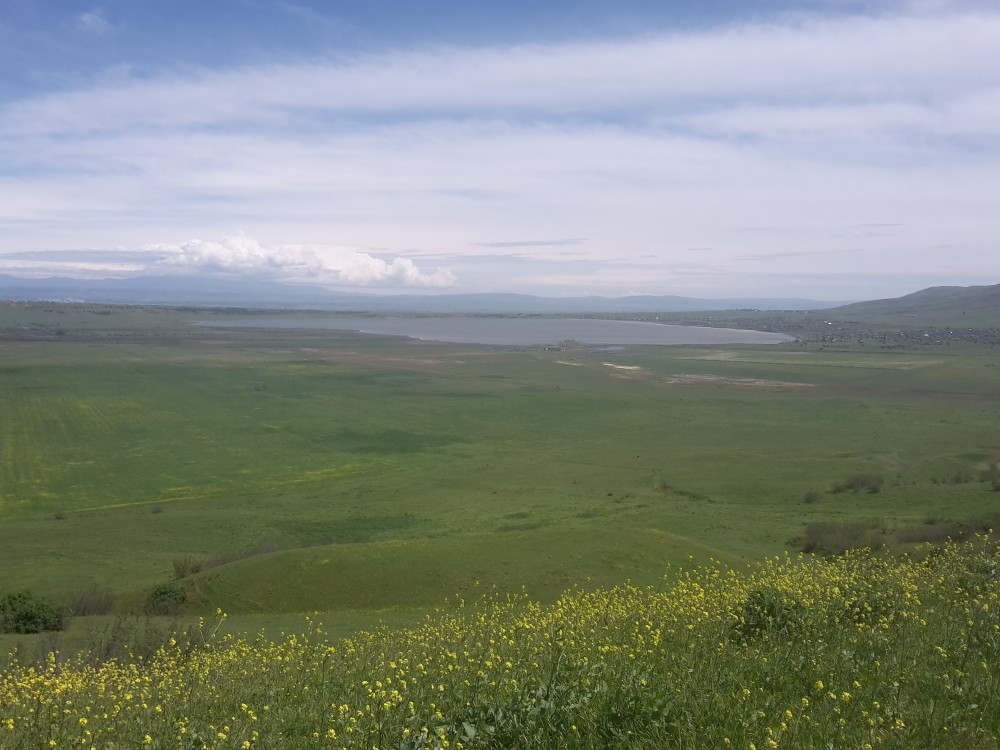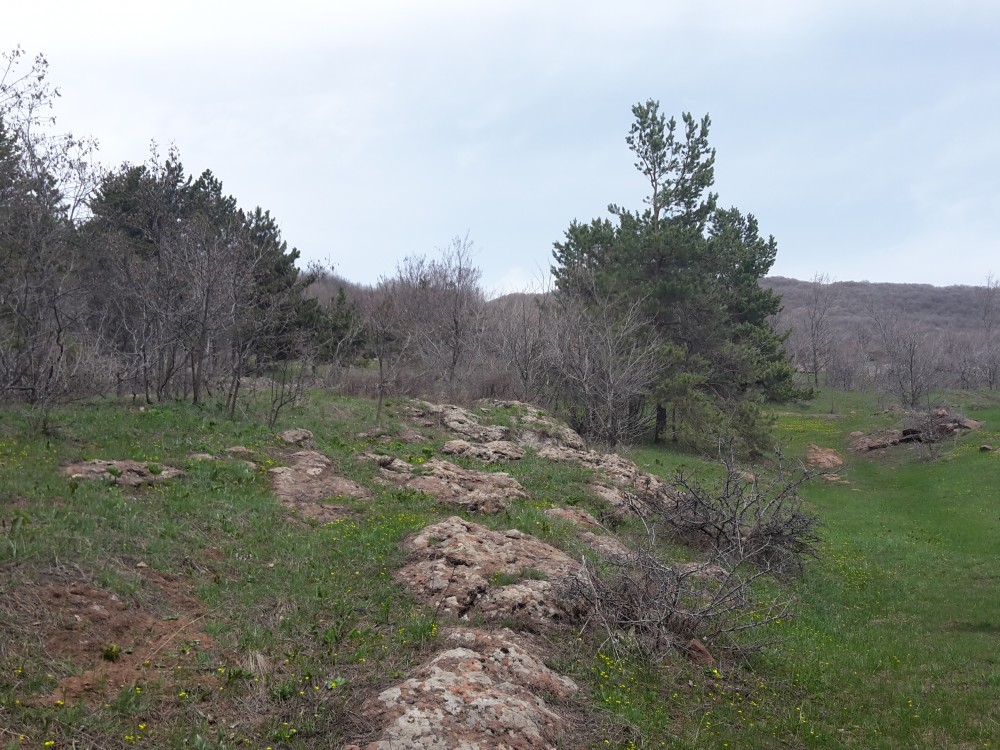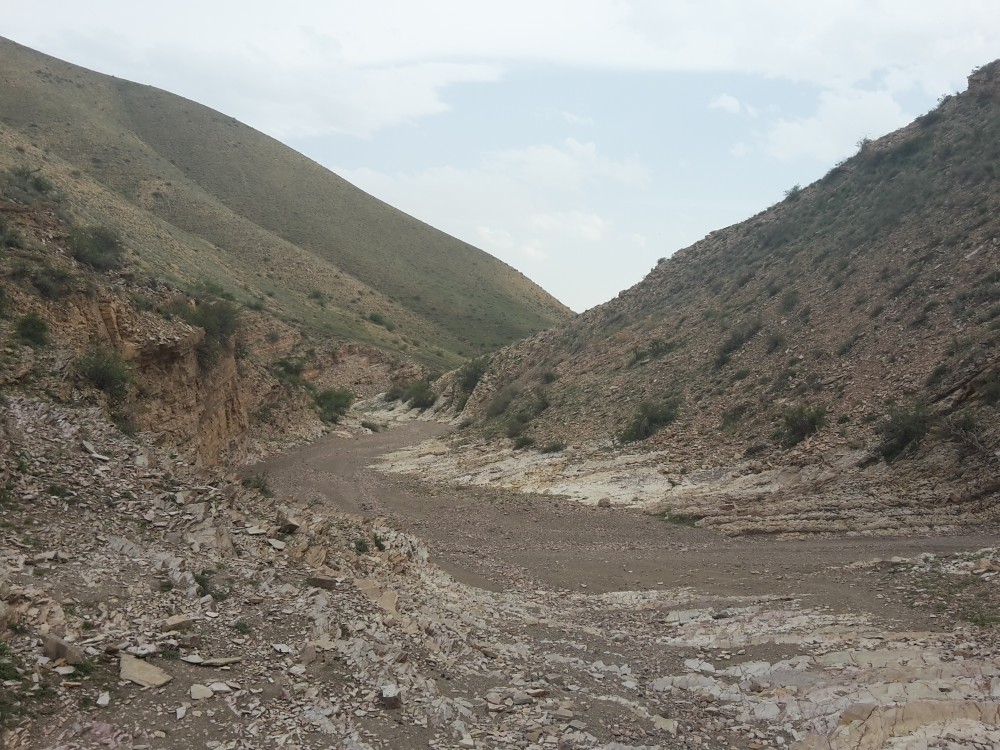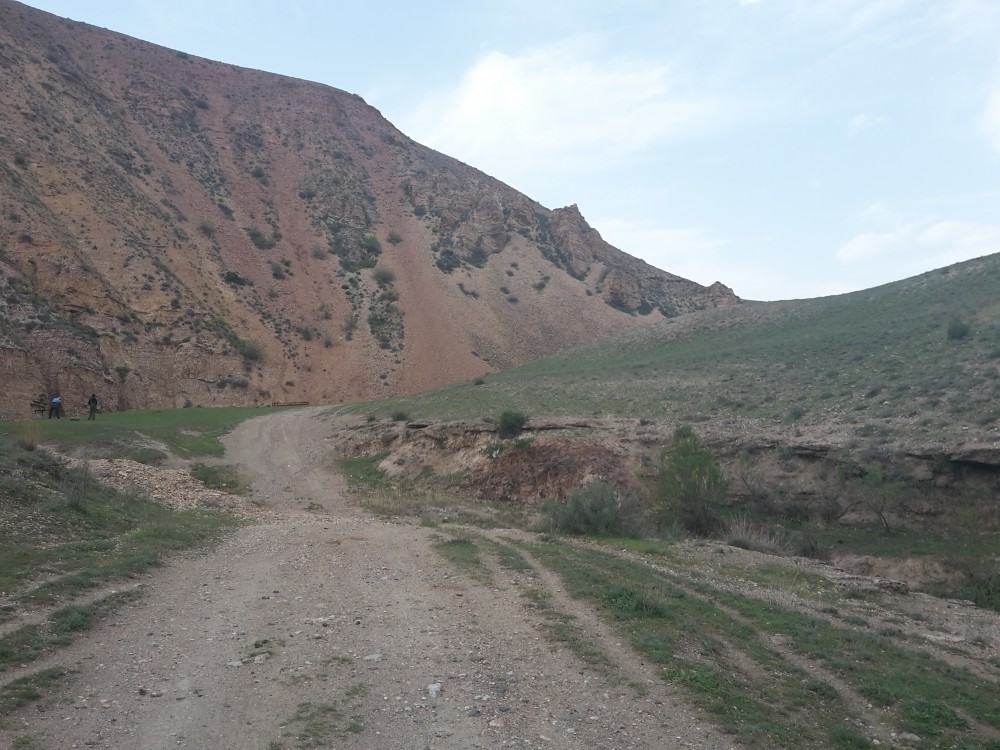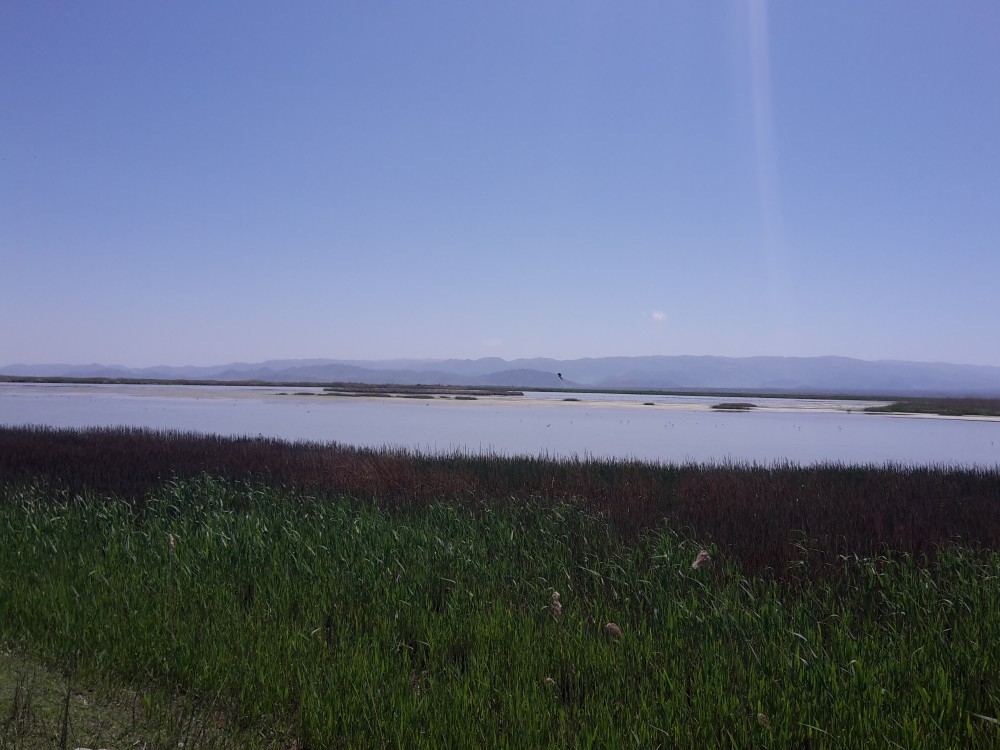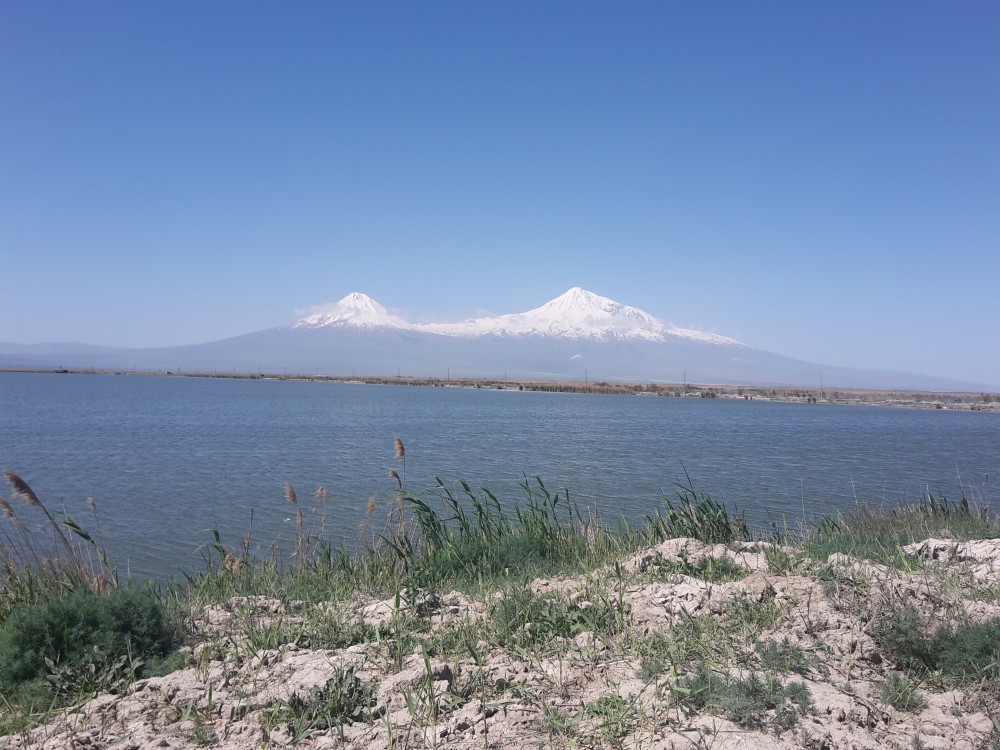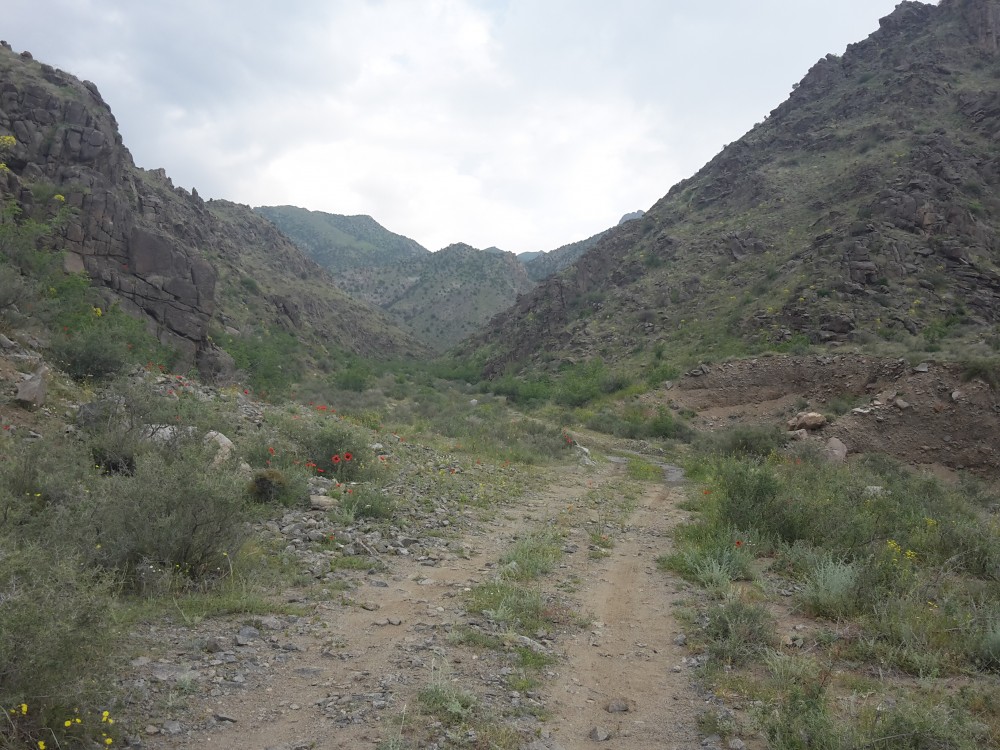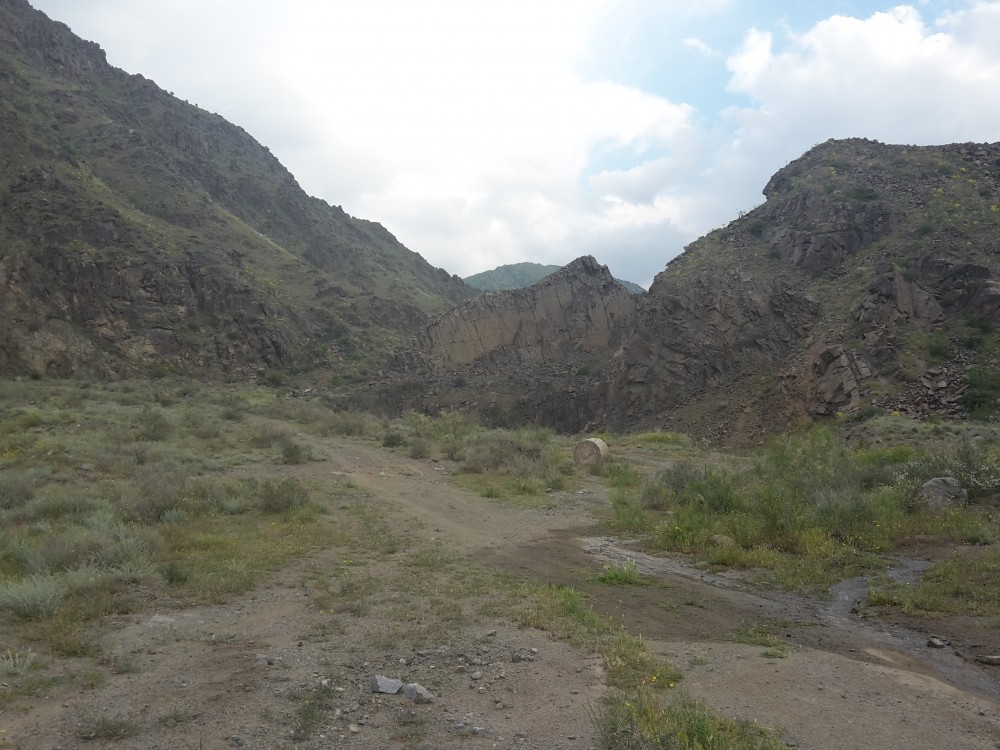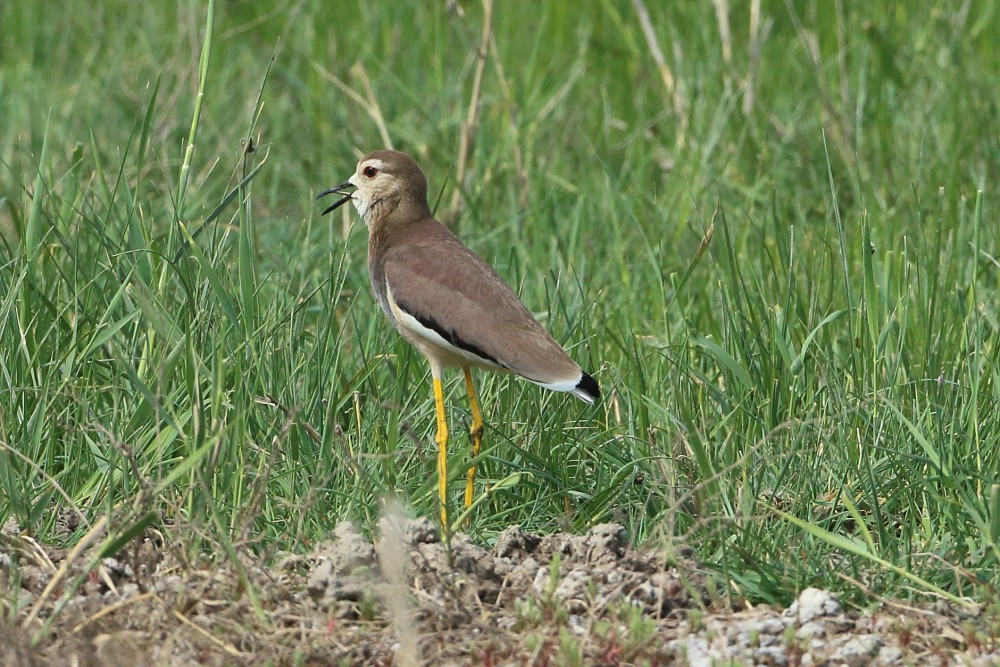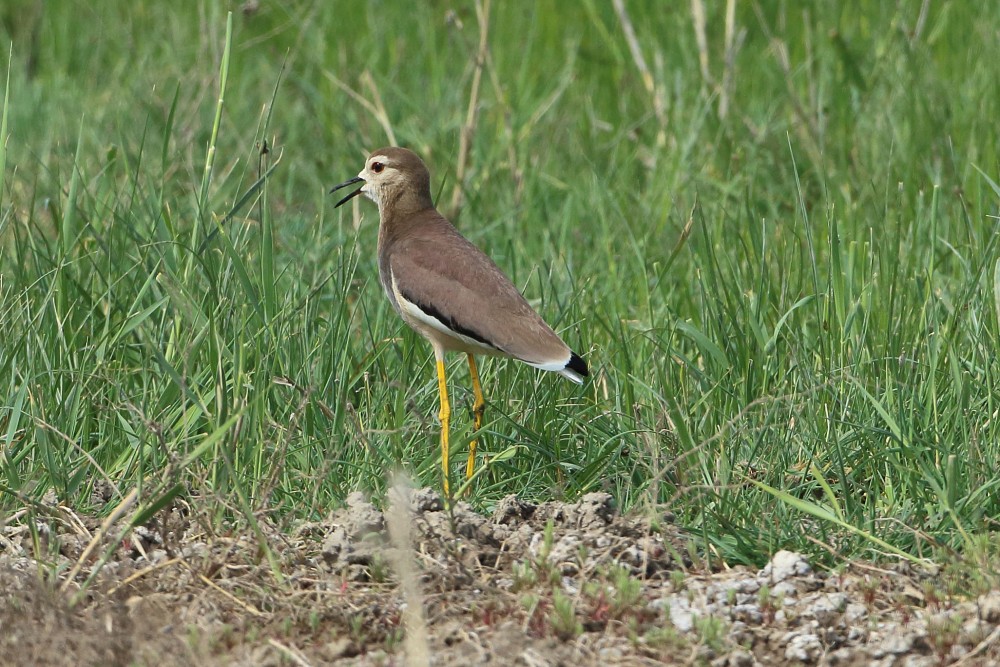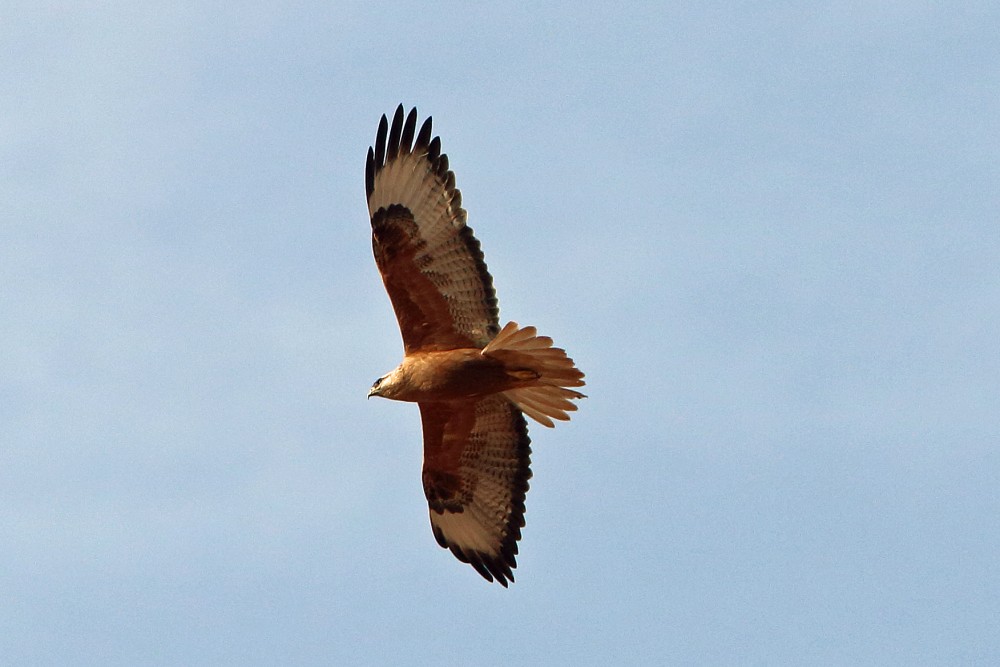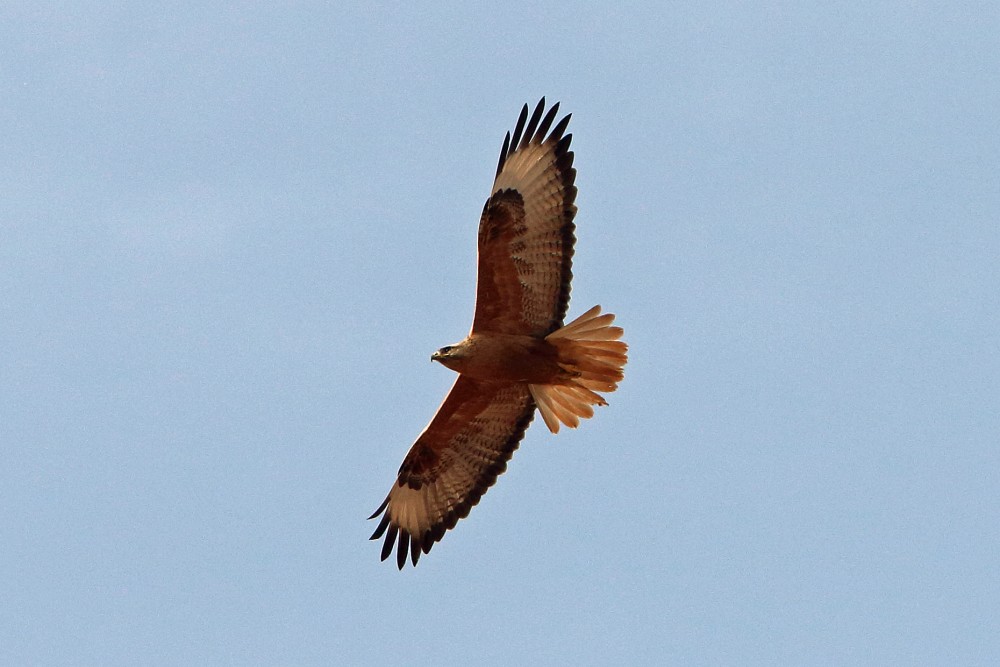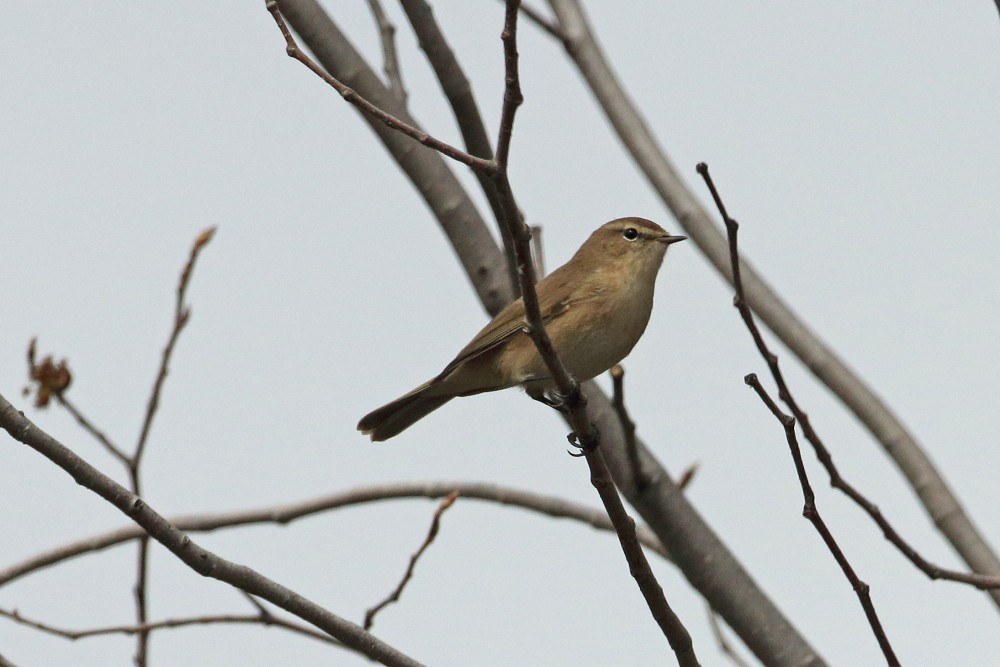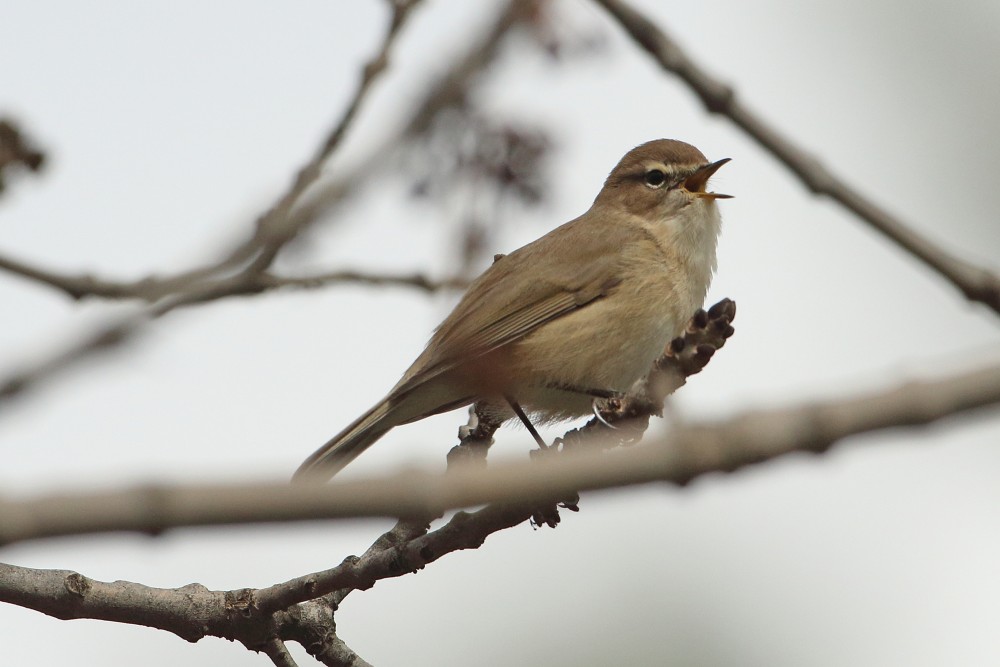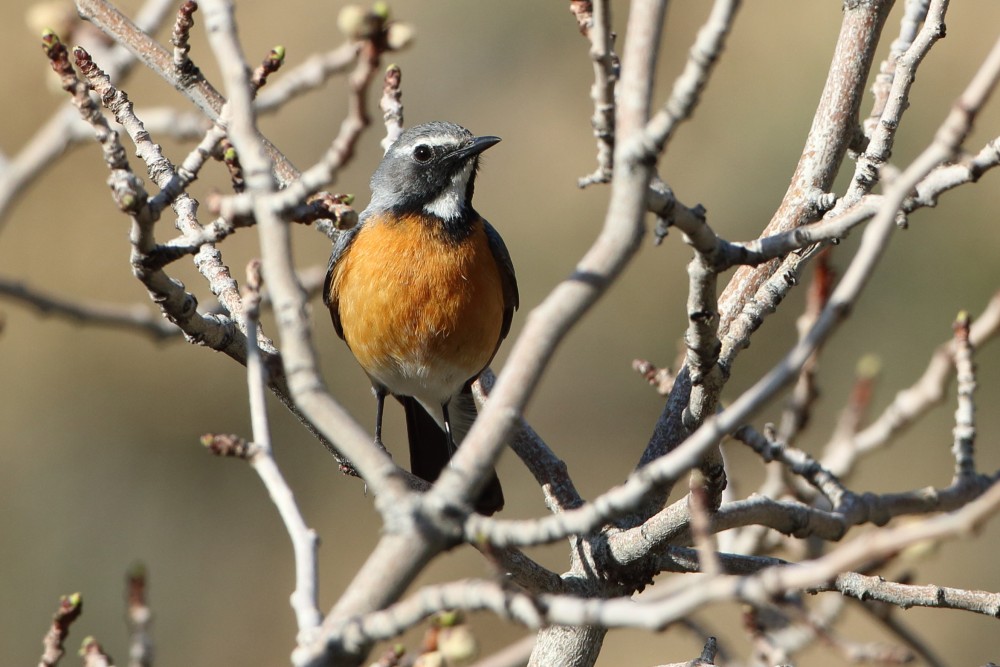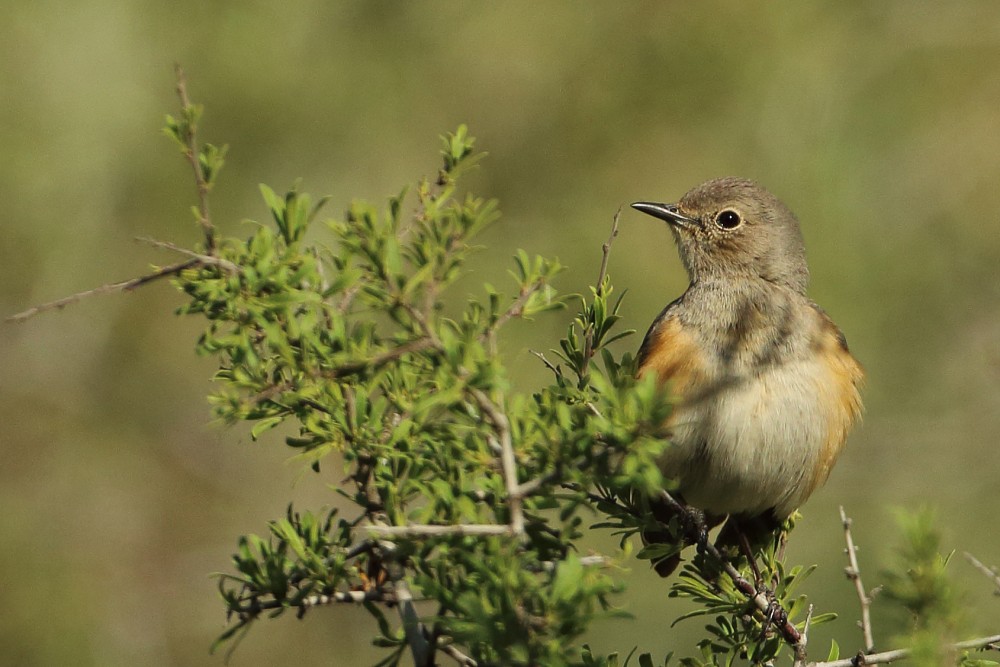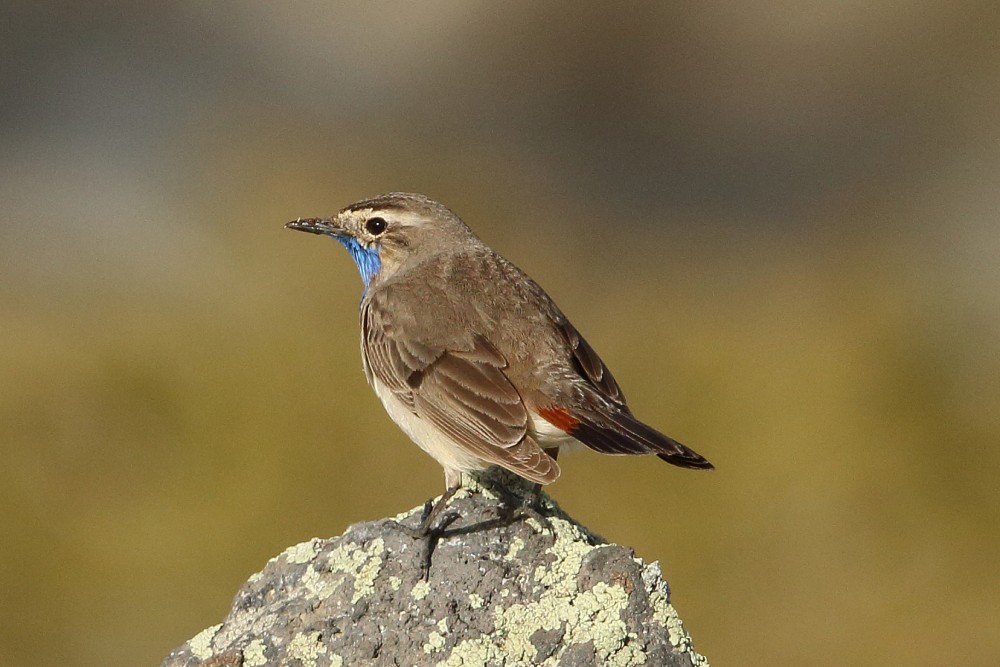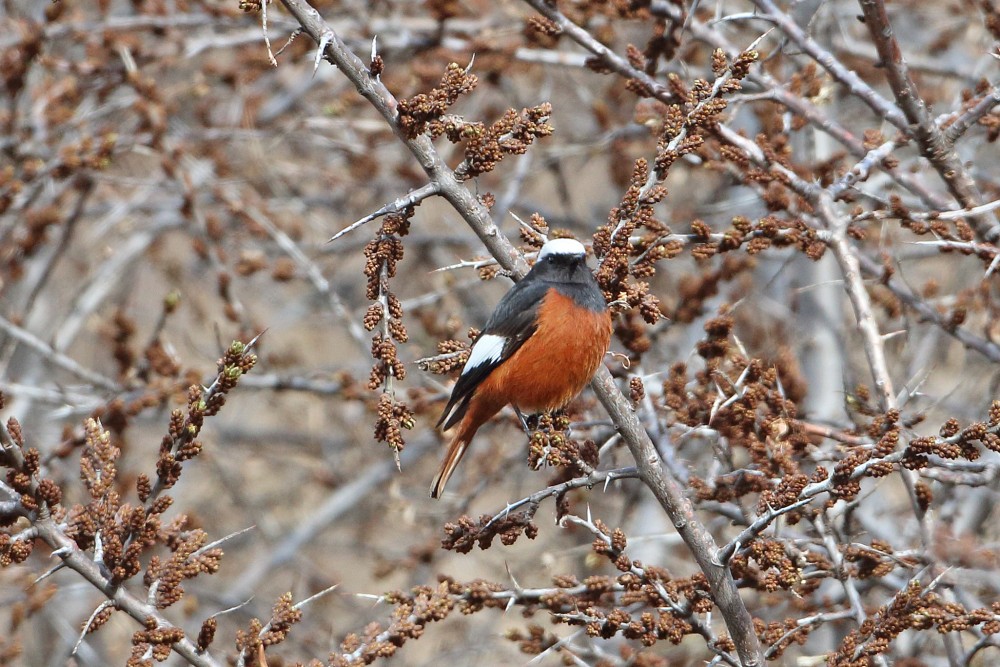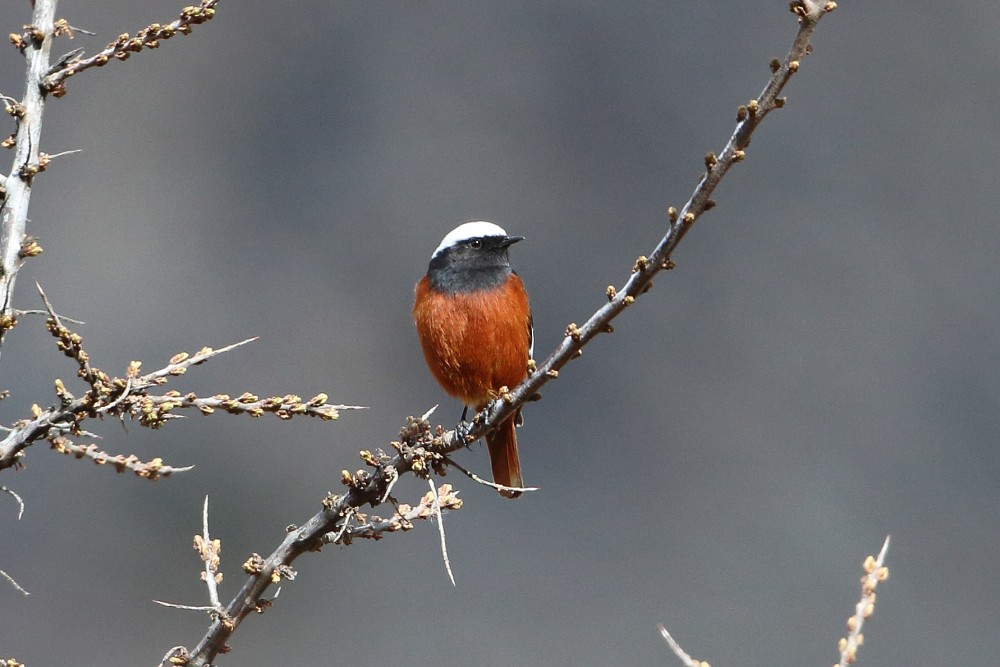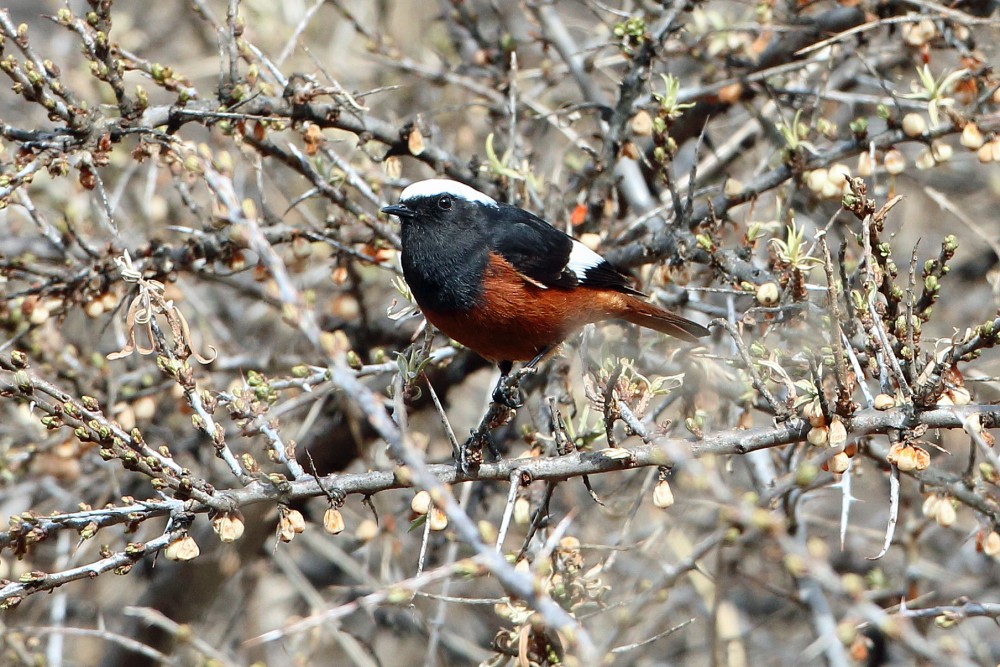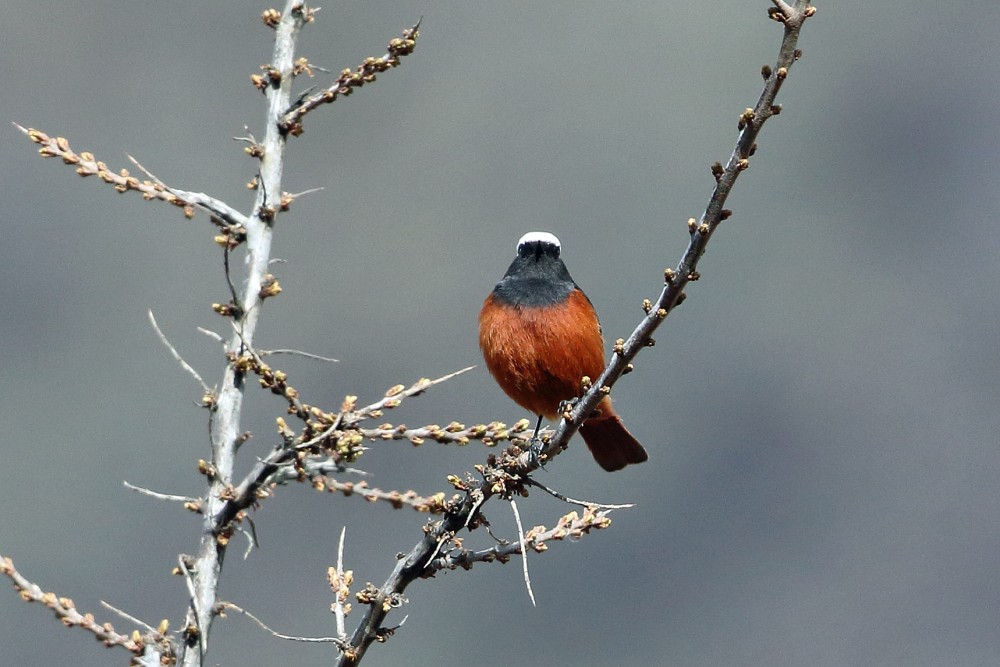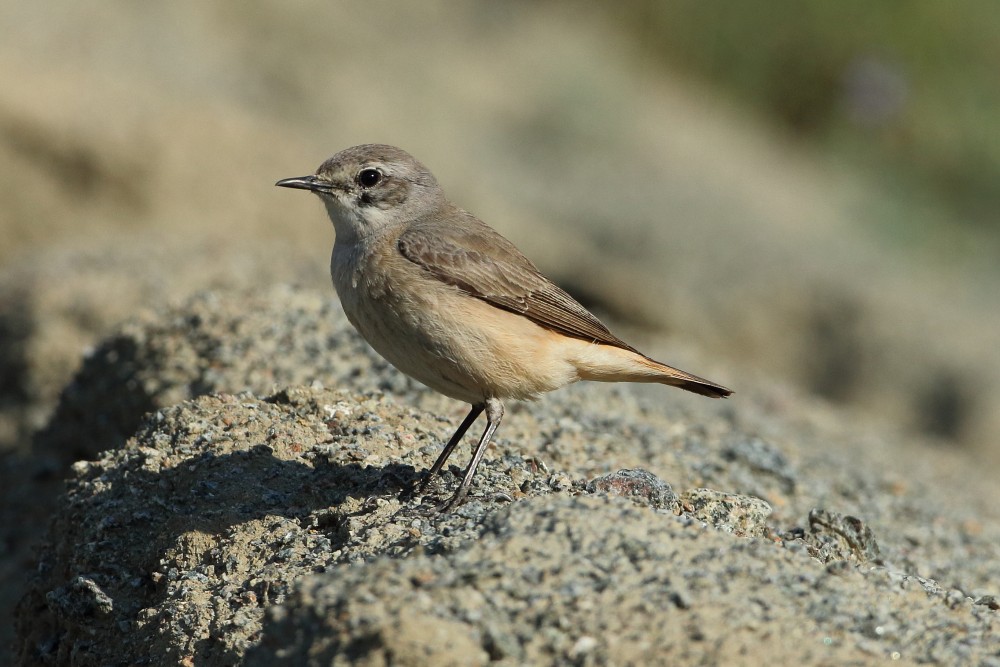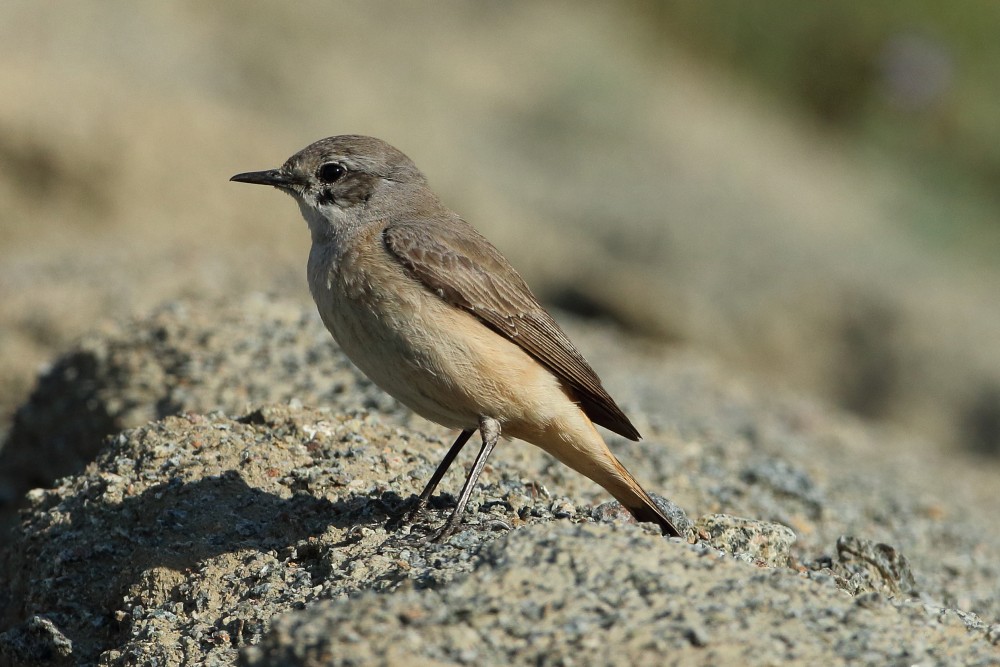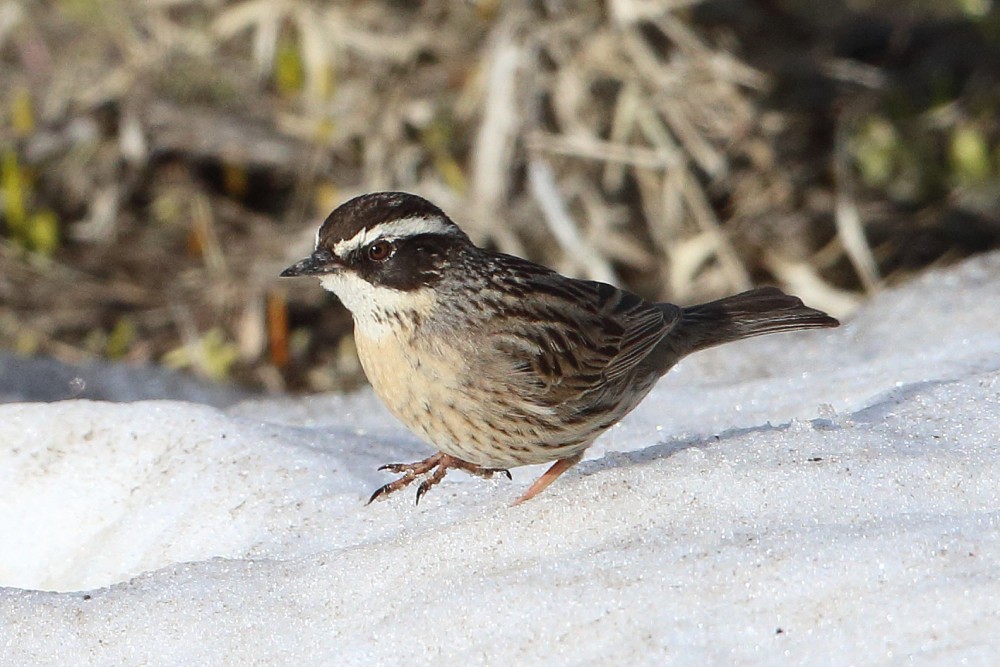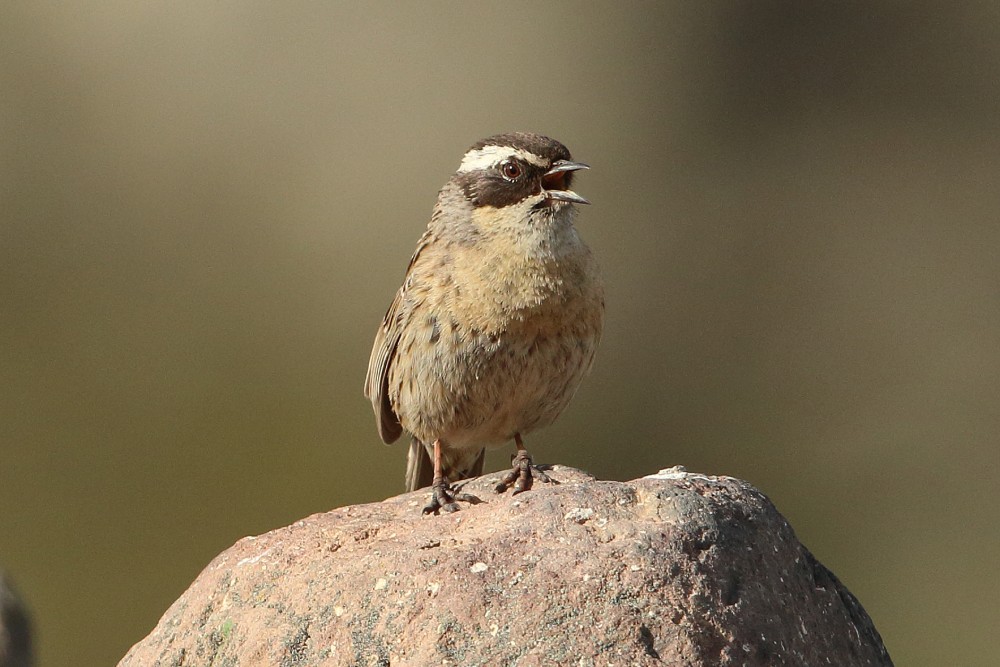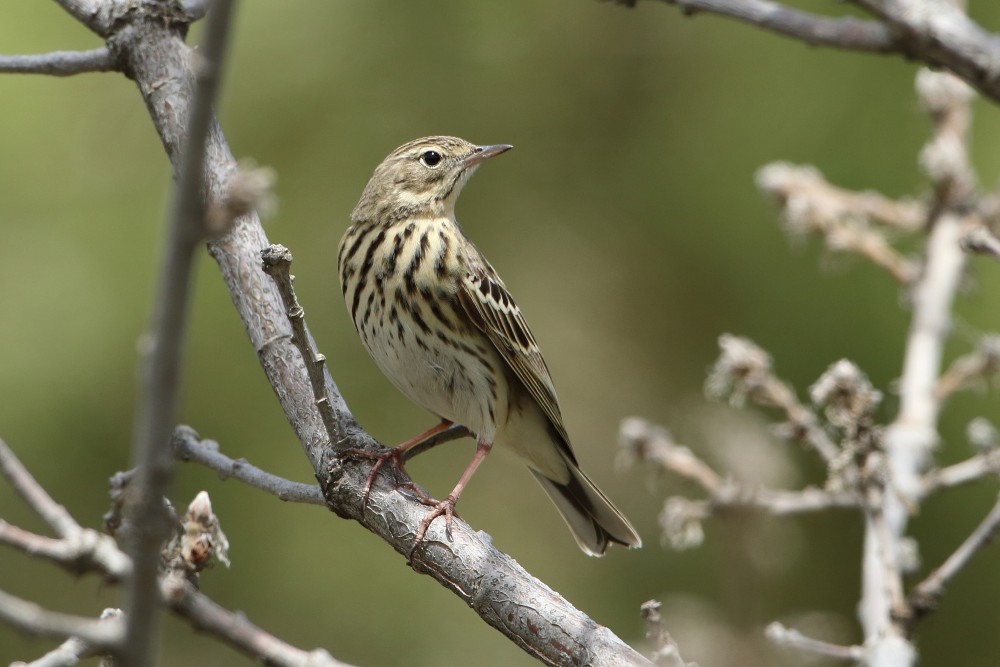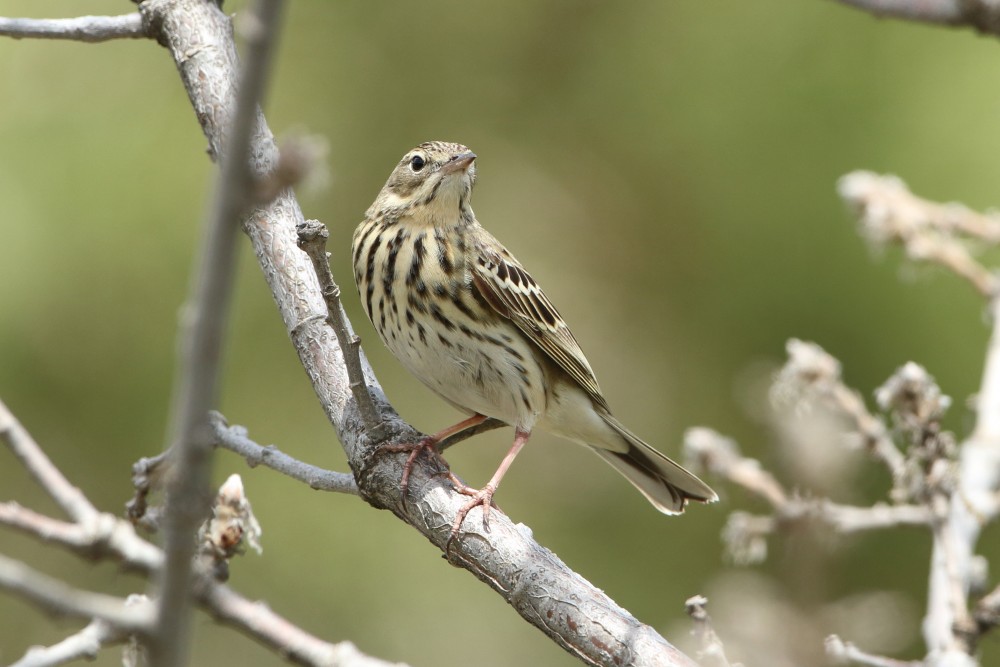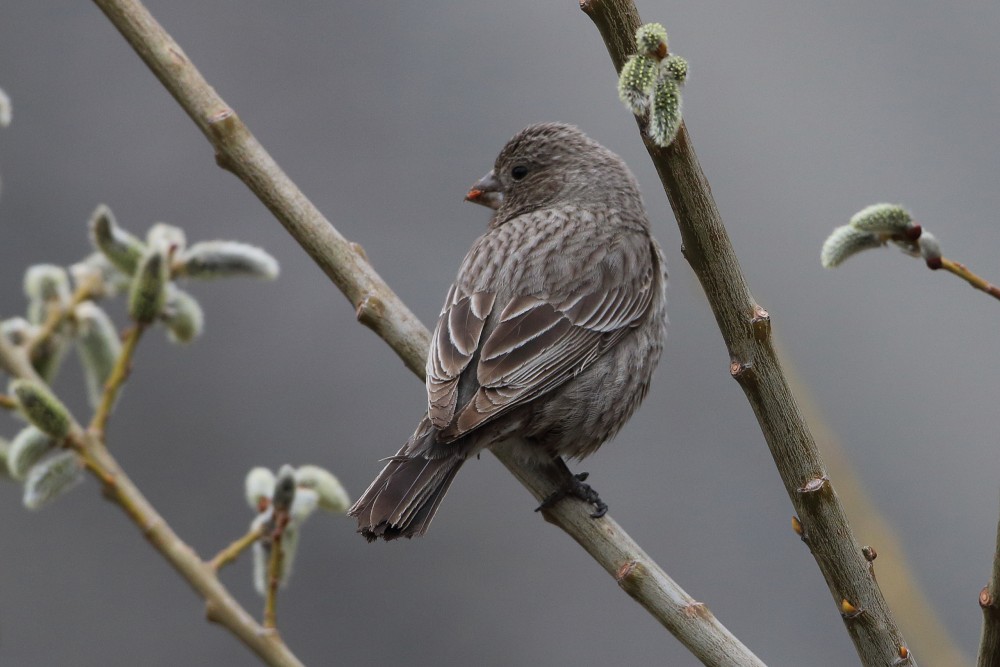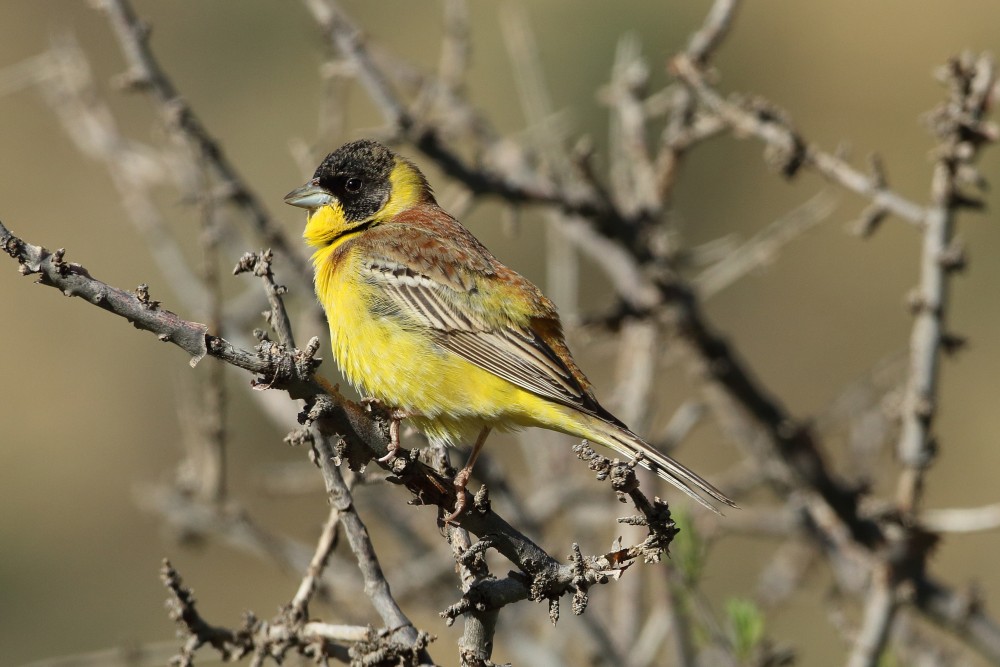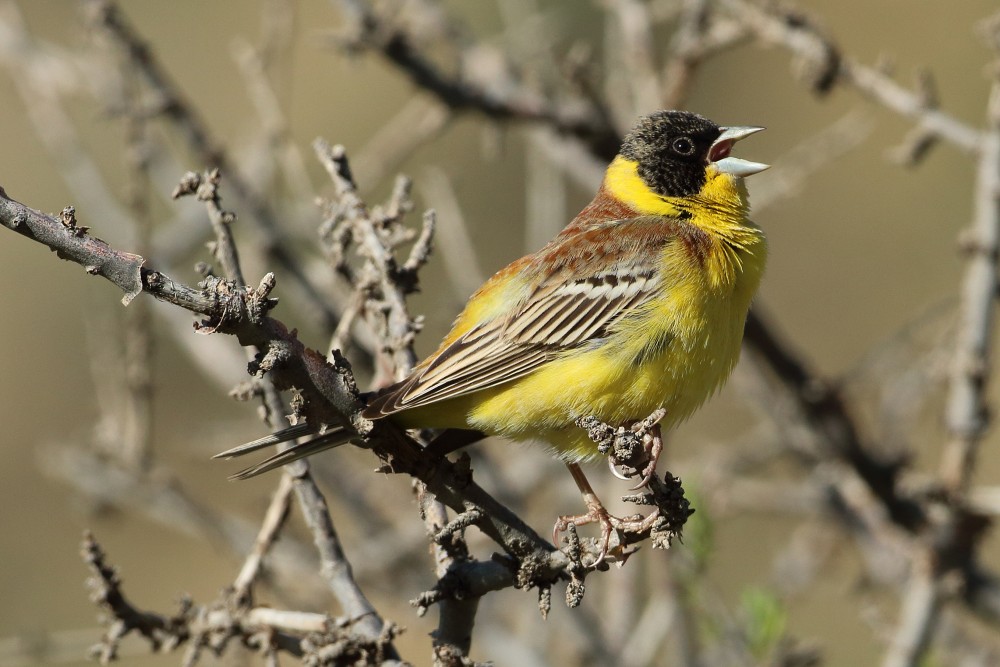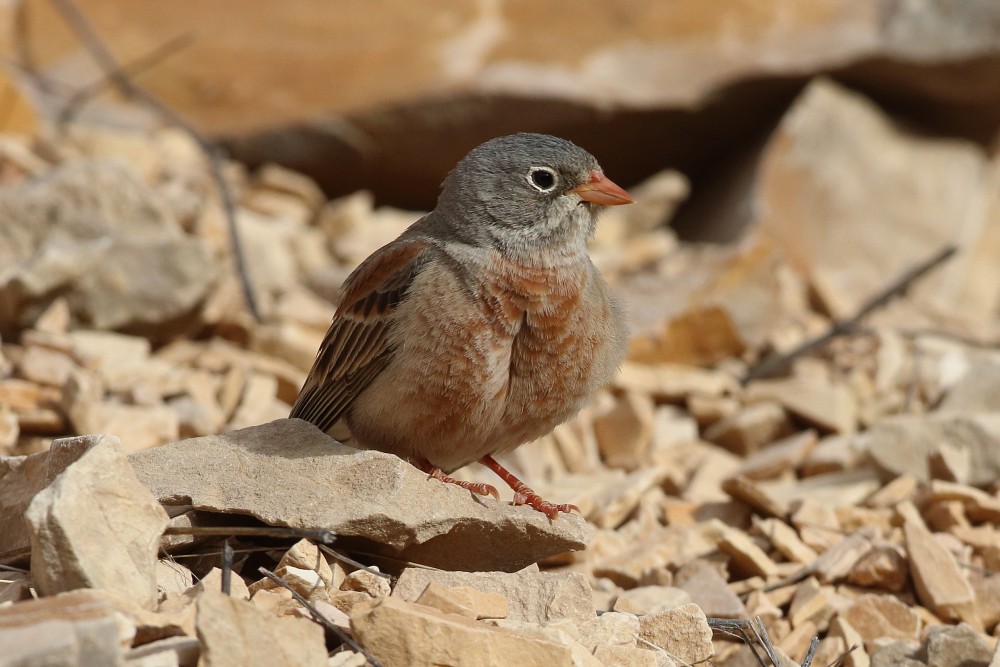Georgia & Armenia
26 April 2015 – 05 May 2015
Visited Sites
- Stepantsminda 26 April 2015 – 28 April 2015
- Fields between Rustavi and Jandari 26 April 2015
- Kumisi Reservoir 26 April 2015
- Mount Aragats summit road 29 April 2015 – 30 April 2015
- Vedi Hills 30 April 2015, 02 May 2015, 03 May 2015 – 04 May 2015
- Jandara Lake 30 April 2015
- Armash Fish Ponds 01 May 2015
- Meghri 02 May 2015 – 03 May 2015
- Dilijan NP 05 May 2015
General Travelling Information
Despite their small size, Georgia and Armenia offer some of the most sought-after bird species in the Western Palearctic. Nowhere else the chance of seing Great Rosefinch, White-winged Redstart, Mountain Chiffchaff, Caucasian Black Grouse and Persian Wheatear are this good. Apart from the famous observation area in Kazbegi, there are other, extremely exciting observation areas. Especially during spring migration period between mid-April and mid-May, when bird species from Central Asia and Russia migrate across Georgia. By the way, this is also the best time for the local specialities mentioned before, which mowe down from their high altitude breeding habitats because of the snow and are thus easier to find in (early) spring. Contrairly, in Armenia, specialties such as Persian Wheatear, Grey-necked Bunting, Green Warbler, Upcher’s Warbler and Pale Rock Sparrow only come back during may from their wintering grounds.
We rented cars from cars4rent.ge which worked very well. It is important, however, to nota that if you have a damage or breakdown, you must immediately inform the insurance before moving the car. If you want to folow up to Armenia with a car hired in Georgia, you need a certified translation of the lease and of the permission. The car rental can do this for you in advance. When entering Armenia, you will have to make an insurance for the rental car again, even if you already have one. Discussing was pointless ;-)
For navigation, the OSM App has been very helpful. The big advantages is that you can use the app offline and that the maps are extremely detailed. It is best to save the exact places already as favorites at home, which saves a lot of time in the field. For longer distances (over 200 km) you should divide the route with intermediate destinations.
Fields between Rustavi and Jandari
The field between Rustavi and Djandara Lake are a known site for Demoiselle Cranes on migration.
Target species
-
 Demoiselle Crane
Anthropoides virgo
Demoiselle Crane
Anthropoides virgo
-
 Cinereous Vulture
Aegypius monachus
Cinereous Vulture
Aegypius monachus
-
 Imperial Eagle
Aquila heliaca
Imperial Eagle
Aquila heliaca
Kumisi Reservoir
Kumasi Lake is located near the capital Tbilisi (approximately 1 hour by car). Especially on the northern shore you can find some good wetlands and some dams from where you have a god view over the lake. During migration you can see virtually every wetland species to be expected to turn up in Georgia. This included Pygmy Cormorant, Ruddy Shelduck, Pallas’s Gull, Armenian Gull and White-winged Tern. Many passerines are resting here on migration like Red-breasted Flycatcher, Bluethroat, variegata Stonechats, Black-headed Wagtail and some Black-eared Wheatears and Pied Wheatears. Migrating raptors can be seen in the sky. According to local birdwatchers Demoiselle Crane is also seen from time to time.
Target species
-
 Demoiselle Crane
Anthropoides virgo
Demoiselle Crane
Anthropoides virgo
-
 Pygmy Cormorant
Microcarbo pygmaeus
Pygmy Cormorant
Microcarbo pygmaeus
-
 Pallas's Gull
Ichthyaetus ichthyaetus
Pallas's Gull
Ichthyaetus ichthyaetus
-
 Armenian Gull
Larus armenicus
Armenian Gull
Larus armenicus
-
 Bluethroat
Luscinia svecica
Bluethroat
Luscinia svecica
-
 Red-breasted Flycatcher
Ficedula parva
Red-breasted Flycatcher
Ficedula parva
-
 Pied Wheatear
Oenanthe pleschanka
Pied Wheatear
Oenanthe pleschanka
Stepantsminda
Stephansminda, also known as Kazbegi, is the best-known birding spot of Georgia. Nowhere else are the chances better to see the birder’s "Big Five" of the Caucasus (Caucasian Grouse, Caucasian Snowcock, Güldenstädt's Redstart, Caucasian Chiffchaff and Great Rosefinch). The best time is early May when the high alpine grouses, the Redstart and the Rosefinch are found much lower because of the snow. They can be found then on the slopes around the village. The bushes south of the village are the best spots to find Güldenstädt's Redstart and Great Rosefinch (in winter to end April). In the small forest below (N42°39'27.82", E44°39'35.06") Red-fronted Serins can be seen and from the coordinates itself you can scan the slopes for grouses and East Caucasian Tur. Caucasian Chiffchaff and other species like Twite, Horned Lark, Lammergeier or Chough can be found around the village. A popular spot to scan for Caucasian Grouse is the famous church of Tsminda Sameba west of the village (N42°39'45.32", E44°37'13.31"). It’s especially worth if the snow has already melted far up.
Target species
-
 Caucasian Snowcock
Tetraogallus caucasicus
Caucasian Snowcock
Tetraogallus caucasicus
-
 Caucasian Grouse
Lyrurus mlokosiewiczi
Caucasian Grouse
Lyrurus mlokosiewiczi
-
 Mountain Chiffchaff
Phylloscopus sindianus
Mountain Chiffchaff
Phylloscopus sindianus
-
 White-winged Redstart
Phoenicurus erythrogastrus
White-winged Redstart
Phoenicurus erythrogastrus
-
 Great Rosefinch
Carpodacus rubicilla
Great Rosefinch
Carpodacus rubicilla
Other wildlife observed
- East Caucasian Tur
Mount Aragats summit road
Target species
-
 Lesser Spotted Eagle
Clanga pomarina
Lesser Spotted Eagle
Clanga pomarina
-
 Horned Lark
Eremophila alpestris
Horned Lark
Eremophila alpestris
-
 Mountain Chiffchaff
Phylloscopus sindianus
Mountain Chiffchaff
Phylloscopus sindianus
-
 White-throated Robin
Irania gutturalis
White-throated Robin
Irania gutturalis
-
 Bluethroat
Luscinia svecica
Bluethroat
Luscinia svecica
-
 Crimson-winged Finch
Rhodopechys sanguineus
Crimson-winged Finch
Rhodopechys sanguineus
-
 Radde's Accentor
Prunella ocularis
Radde's Accentor
Prunella ocularis
Facilities & accommodation
Hotel: 40.296550° 44.296394°
Jandara Lake
The lake holds the same species like Kumisi Lake.
Vedi Hills
The Grey-necked Bunting is easy to find around the watering hole. In addition, Finch’s Wheatear, Eastern- and Western Rock Nuthatch is present, too. From mid-May onwards you can also find Upcher’s Warbler and Pale Rock Sparrow.
Target species
-
 Egyptian Vulture
Neophron percnopterus
Egyptian Vulture
Neophron percnopterus
-
 Lanner Falcon
Falco biarmicus
Lanner Falcon
Falco biarmicus
-
 Upcher's Warbler
Hippolais languida
Upcher's Warbler
Hippolais languida
-
 Western Rock Nuthatch
Sitta neumayer
Western Rock Nuthatch
Sitta neumayer
-
 Eastern Rock Nuthatch
Sitta tephronota
Eastern Rock Nuthatch
Sitta tephronota
-
 Finsch's Wheatear
Oenanthe finschii
Finsch's Wheatear
Oenanthe finschii
-
 Pale Rockfinch
Carpospiza brachydactyla
Pale Rockfinch
Carpospiza brachydactyla
-
 Mongolian Finch
Bucanetes mongolicus
Mongolian Finch
Bucanetes mongolicus
extremely rare
-
 Gray-necked Bunting
Emberiza buchanani
Gray-necked Bunting
Emberiza buchanani
Facilities & accommodation
There are very few hotels in this region. We stayed in the very basic hotel oazis (39.920219°,44.752764°) in the neighboring village Dashtakar. From here you are quickly in the Vedi Hills and not too far away from Armash Fish Ponds.
Armash Fish Ponds
The Armash Fish Ponds are a very impressive wetland with thousands of terns, waders and other birds. Among them you can spot specialties such as White-tailed Lapwing, Thrush Nightingale, Blue-cheeked Bee-eater and Paddifield Warbler. During the migration season, you may find rare species such as Black-winged Pratincole, Terek Sandpiper, Great Snipe and Broad-billed Sandpiper.
Since the Armash Fish Ponds are private, Ananian Vasil (vasil.ananian@gmail.com) has organized the entry for us. He can also provide other useful tips for your trip.
Target species
-
 White-tailed Lapwing
Vanellus leucurus
White-tailed Lapwing
Vanellus leucurus
-
 Paddyfield Warbler
Acrocephalus agricola
Paddyfield Warbler
Acrocephalus agricola
-
 Menetries's Warbler
Curruca mystacea
Menetries's Warbler
Curruca mystacea
-
 Thrush Nightingale
Luscinia luscinia
Thrush Nightingale
Luscinia luscinia
Meghri
Right here on the border with Iran is the most reliable place for the Persian Wheatear.
Facilities & accommodation
Overnight we stayed in the budget hotel Mila (38.919238°, 46.222163°) just above Meghri.
Dilijan NP
Dilijan National Park is best known for the high densities of Green Warbler. But you can also find the rare semi-collared Flycatcher here.
Target species
-
 Lesser Spotted Eagle
Clanga pomarina
Lesser Spotted Eagle
Clanga pomarina
-
 Green Warbler
Phylloscopus nitidus
Green Warbler
Phylloscopus nitidus
-
 Semicollared Flycatcher
Ficedula semitorquata
Semicollared Flycatcher
Ficedula semitorquata
Species List
-
 Ruddy Shelduck
Tadorna ferruginea
details
sounds
Ruddy Shelduck
Tadorna ferruginea
details
sounds
-
Armash Fish Ponds
-
-
 Common Shelduck
Tadorna tadorna
details
sounds
Common Shelduck
Tadorna tadorna
details
sounds
-
Armash Fish Ponds
-
-
 Garganey
Spatula querquedula
details
sounds
Garganey
Spatula querquedula
details
sounds
-
Armash Fish Ponds
-
-
 Northern Shoveler
Spatula clypeata
details
sounds
Northern Shoveler
Spatula clypeata
details
sounds
-
Armash Fish Ponds
-
-
 Gadwall
Mareca strepera
details
sounds
Gadwall
Mareca strepera
details
sounds
-
Armash Fish Ponds
-
-
 Mallard
Anas platyrhynchos
details
sounds
Mallard
Anas platyrhynchos
details
sounds
-
Armash Fish Ponds
-
-
 Green-winged Teal
Anas crecca
details
sounds
Green-winged Teal
Anas crecca
details
sounds
-
Armash Fish Ponds
-
-
 Marbled Duck
Marmaronetta angustirostris
details
sounds
Marbled Duck
Marmaronetta angustirostris
details
sounds
-
Armash Fish Ponds
-
-
 Red-crested Pochard
Netta rufina
details
sounds
Red-crested Pochard
Netta rufina
details
sounds
-
Armash Fish Ponds
-
-
 Common Pochard
Aythya ferina
details
sounds
Common Pochard
Aythya ferina
details
sounds
-
Armash Fish Ponds
-
-
 Ferruginous Duck
Aythya nyroca
details
sounds
Ferruginous Duck
Aythya nyroca
details
sounds
-
Armash Fish Ponds
-
-
 White-headed Duck
Oxyura leucocephala
details
sounds
White-headed Duck
Oxyura leucocephala
details
sounds
-
Armash Fish Ponds
2015-05-01 8 ind.
-
-
 Caucasian Grouse
Lyrurus mlokosiewiczi
details
sounds
Caucasian Grouse
Lyrurus mlokosiewiczi
details
sounds
-
Stepantsminda
2015-04-26 3 ind. 2015-04-27 ≈ 11 ind.
-
-
 Caucasian Snowcock
Tetraogallus caucasicus
details
sounds
Caucasian Snowcock
Tetraogallus caucasicus
details
sounds
-
Stepantsminda
2015-04-26 2 ind. 2015-04-27 ≈ 9 ind. (heard only)
-
-
 Common Quail
Coturnix coturnix
Common Quail
Coturnix coturnix
-
 Chukar
Alectoris chukar
details
sounds
Chukar
Alectoris chukar
details
sounds
-
Meghri
2015-05-03 1 ind.
-
-
 Greater Flamingo
Phoenicopterus roseus
details
sounds
Greater Flamingo
Phoenicopterus roseus
details
sounds
-
Armash Fish Ponds
2015-05-01 ≥ 60 ind.
-
-
 Little Grebe
Tachybaptus ruficollis
details
sounds
Little Grebe
Tachybaptus ruficollis
details
sounds
-
Armash Fish Ponds
-
-
 Great Crested Grebe
Podiceps cristatus
details
sounds
Great Crested Grebe
Podiceps cristatus
details
sounds
-
Armash Fish Ponds
-
-
 Eared Grebe
Podiceps nigricollis
details
sounds
Eared Grebe
Podiceps nigricollis
details
sounds
-
Armash Fish Ponds
-
-
 Rock Pigeon
Columba livia
Rock Pigeon
Columba livia
-
 Stock Dove
Columba oenas
Stock Dove
Columba oenas
-
 Common Wood-Pigeon
Columba palumbus
Common Wood-Pigeon
Columba palumbus
-
 Eurasian Collared-Dove
Streptopelia decaocto
Eurasian Collared-Dove
Streptopelia decaocto
-
 Laughing Dove
Spilopelia senegalensis
details
sounds
Laughing Dove
Spilopelia senegalensis
details
sounds
-
Vedi Hills
2015-05-02 2 ind.
-
-
 Common Cuckoo
Cuculus canorus
Common Cuckoo
Cuculus canorus
-
 Alpine Swift
Tachymarptis melba
details
sounds
Alpine Swift
Tachymarptis melba
details
sounds
-
Stepantsminda
-
Dilijan NP
-
-
 Common Swift
Apus apus
details
sounds
Common Swift
Apus apus
details
sounds
-
enroute
daily
-
-
 Spotted Crake
Porzana porzana
details
sounds
Spotted Crake
Porzana porzana
details
sounds
-
Armash Fish Ponds
2015-05-01 2 ind.
-
-
 Eurasian Moorhen
Gallinula chloropus
details
sounds
Eurasian Moorhen
Gallinula chloropus
details
sounds
-
Armash Fish Ponds
-
-
 Eurasian Coot
Fulica atra
details
sounds
Eurasian Coot
Fulica atra
details
sounds
-
Armash Fish Ponds
-
-
 Demoiselle Crane
Anthropoides virgo
details
sounds
Demoiselle Crane
Anthropoides virgo
details
sounds
-
 Black-winged Stilt
Himantopus himantopus
details
sounds
Black-winged Stilt
Himantopus himantopus
details
sounds
-
Kumisi Reservoir
-
Jandara Lake
-
Armash Fish Ponds
-
-
 Pied Avocet
Recurvirostra avosetta
details
sounds
Pied Avocet
Recurvirostra avosetta
details
sounds
-
Armash Fish Ponds
-
-
 Black-bellied Plover
Pluvialis squatarola
details
sounds
Black-bellied Plover
Pluvialis squatarola
details
sounds
-
Armash Fish Ponds
-
-
 Common Ringed Plover
Charadrius hiaticula
details
sounds
Common Ringed Plover
Charadrius hiaticula
details
sounds
-
Armash Fish Ponds
-
-
 Little Ringed Plover
Charadrius dubius
details
sounds
Little Ringed Plover
Charadrius dubius
details
sounds
-
Armash Fish Ponds
-
-
 Northern Lapwing
Vanellus vanellus
details
sounds
Northern Lapwing
Vanellus vanellus
details
sounds
-
Armash Fish Ponds
-
-
 White-tailed Lapwing
Vanellus leucurus
details
sounds
White-tailed Lapwing
Vanellus leucurus
details
sounds
-
 Greater Sand-Plover
Anarhynchus leschenaultii
details
sounds
Greater Sand-Plover
Anarhynchus leschenaultii
details
sounds
-
Armash Fish Ponds
2015-05-01 1 ind.
-
-
 Kentish Plover
Anarhynchus alexandrinus
details
sounds
Kentish Plover
Anarhynchus alexandrinus
details
sounds
-
Armash Fish Ponds
-
-
 Eurasian Curlew
Numenius arquata
details
sounds
Eurasian Curlew
Numenius arquata
details
sounds
-
Armash Fish Ponds
-
-
 Black-tailed Godwit
Limosa limosa
details
sounds
Black-tailed Godwit
Limosa limosa
details
sounds
-
Armash Fish Ponds
-
-
 Great Snipe
Gallinago media
details
sounds
Great Snipe
Gallinago media
details
sounds
-
Armash Fish Ponds
-
-
 Common Snipe
Gallinago gallinago
details
sounds
Common Snipe
Gallinago gallinago
details
sounds
-
Armash Fish Ponds
-
-
 Red-necked Phalarope
Phalaropus lobatus
details
sounds
Red-necked Phalarope
Phalaropus lobatus
details
sounds
-
Armash Fish Ponds
2015-05-01 29 ind.
-
-
 Terek Sandpiper
Xenus cinereus
details
sounds
Terek Sandpiper
Xenus cinereus
details
sounds
-
Armash Fish Ponds
2015-05-01 1 ind.
-
-
 Common Sandpiper
Actitis hypoleucos
details
sounds
Common Sandpiper
Actitis hypoleucos
details
sounds
-
Armash Fish Ponds
-
-
 Green Sandpiper
Tringa ochropus
details
sounds
Green Sandpiper
Tringa ochropus
details
sounds
-
Kumisi Reservoir
-
Jandara Lake
-
Armash Fish Ponds
-
-
 Marsh Sandpiper
Tringa stagnatilis
details
sounds
Marsh Sandpiper
Tringa stagnatilis
details
sounds
-
Jandara Lake
-
Armash Fish Ponds
-
-
 Wood Sandpiper
Tringa glareola
details
sounds
Wood Sandpiper
Tringa glareola
details
sounds
-
Armash Fish Ponds
-
-
 Common Redshank
Tringa totanus
details
sounds
Common Redshank
Tringa totanus
details
sounds
-
Kumisi Reservoir
-
Armash Fish Ponds
-
-
 Spotted Redshank
Tringa erythropus
details
sounds
Spotted Redshank
Tringa erythropus
details
sounds
-
Armash Fish Ponds
-
-
 Common Greenshank
Tringa nebularia
details
sounds
Common Greenshank
Tringa nebularia
details
sounds
-
Jandara Lake
-
Armash Fish Ponds
-
-
 Ruff
Calidris pugnax
details
sounds
Ruff
Calidris pugnax
details
sounds
-
Kumisi Reservoir
-
Jandara Lake
-
Armash Fish Ponds
-
-
 Broad-billed Sandpiper
Calidris falcinellus
details
sounds
Broad-billed Sandpiper
Calidris falcinellus
details
sounds
-
Armash Fish Ponds
2015-05-01 3 ind.
-
-
 Curlew Sandpiper
Calidris ferruginea
details
sounds
Curlew Sandpiper
Calidris ferruginea
details
sounds
-
Armash Fish Ponds
-
-
 Temminck's Stint
Calidris temminckii
details
sounds
Temminck's Stint
Calidris temminckii
details
sounds
-
Armash Fish Ponds
-
-
 Dunlin
Calidris alpina
details
sounds
Dunlin
Calidris alpina
details
sounds
-
Armash Fish Ponds
-
-
 Little Stint
Calidris minuta
details
sounds
Little Stint
Calidris minuta
details
sounds
-
Armash Fish Ponds
-
-
 Black-winged Pratincole
Glareola nordmanni
details
sounds
Black-winged Pratincole
Glareola nordmanni
details
sounds
-
Armash Fish Ponds
2015-05-01 1 ind.
-
-
 Collared Pratincole
Glareola pratincola
details
sounds
Collared Pratincole
Glareola pratincola
details
sounds
-
Armash Fish Ponds
-
-
 Slender-billed Gull
Chroicocephalus genei
details
sounds
Slender-billed Gull
Chroicocephalus genei
details
sounds
-
Armash Fish Ponds
-
-
 Black-headed Gull
Chroicocephalus ridibundus
details
sounds
Black-headed Gull
Chroicocephalus ridibundus
details
sounds
-
Armash Fish Ponds
-
-
 Caspian Gull
Larus cachinnans
details
sounds
Caspian Gull
Larus cachinnans
details
sounds
-
Armash Fish Ponds
-
-
 Armenian Gull
Larus armenicus
Armenian Gull
Larus armenicus
-
 Little Tern
Sternula albifrons
details
sounds
Little Tern
Sternula albifrons
details
sounds
-
Armash Fish Ponds
-
-
 Gull-billed Tern
Gelochelidon nilotica
details
sounds
Gull-billed Tern
Gelochelidon nilotica
details
sounds
-
Jandara Lake
-
Armash Fish Ponds
-
-
 Black Tern
Chlidonias niger
details
sounds
Black Tern
Chlidonias niger
details
sounds
-
Armash Fish Ponds
-
-
 White-winged Tern
Chlidonias leucopterus
White-winged Tern
Chlidonias leucopterus
-
 Common Tern
Sterna hirundo
details
sounds
Common Tern
Sterna hirundo
details
sounds
-
Armash Fish Ponds
-
-
 White Stork
Ciconia ciconia
White Stork
Ciconia ciconia
-
 Pygmy Cormorant
Microcarbo pygmaeus
details
sounds
Pygmy Cormorant
Microcarbo pygmaeus
details
sounds
-
Armash Fish Ponds
-
-
 Black-crowned Night Heron
Nycticorax nycticorax
details
sounds
Black-crowned Night Heron
Nycticorax nycticorax
details
sounds
-
Armash Fish Ponds
-
-
 Little Egret
Egretta garzetta
Little Egret
Egretta garzetta
-
 Squacco Heron
Ardeola ralloides
details
sounds
Squacco Heron
Ardeola ralloides
details
sounds
-
Armash Fish Ponds
-
-
 Western Cattle Egret
Bubulcus ibis
details
sounds
Western Cattle Egret
Bubulcus ibis
details
sounds
-
Armash Fish Ponds
-
-
 Great Egret
Ardea alba
details
sounds
Great Egret
Ardea alba
details
sounds
-
Armash Fish Ponds
-
-
 Gray Heron
Ardea cinerea
Gray Heron
Ardea cinerea
-
 Purple Heron
Ardea purpurea
details
sounds
Purple Heron
Ardea purpurea
details
sounds
-
Armash Fish Ponds
-
-
 Glossy Ibis
Plegadis falcinellus
details
sounds
Glossy Ibis
Plegadis falcinellus
details
sounds
-
Armash Fish Ponds
-
-
 Eurasian Spoonbill
Platalea leucorodia
details
sounds
Eurasian Spoonbill
Platalea leucorodia
details
sounds
-
Armash Fish Ponds
2015-05-01 10 ind.
-
-
 Bearded Vulture
Gypaetus barbatus
details
sounds
Bearded Vulture
Gypaetus barbatus
details
sounds
-
Stepantsminda
-
-
 Egyptian Vulture
Neophron percnopterus
Egyptian Vulture
Neophron percnopterus
-
 European Honey-buzzard
Pernis apivorus
European Honey-buzzard
Pernis apivorus
-
 Cinereous Vulture
Aegypius monachus
details
sounds
Cinereous Vulture
Aegypius monachus
details
sounds
-
Fields between Rustavi and Jandari
2015-04-26 9 ind.
-
-
 Eurasian Griffon
Gyps fulvus
details
sounds
Eurasian Griffon
Gyps fulvus
details
sounds
-
Fields between Rustavi and Jandari
-
Mount Aragats summit road
-
-
 Short-toed Snake-Eagle
Circaetus gallicus
details
sounds
Short-toed Snake-Eagle
Circaetus gallicus
details
sounds
-
Fields between Rustavi and Jandari
-
Mount Aragats summit road
-
-
 Lesser Spotted Eagle
Clanga pomarina
details
sounds
Lesser Spotted Eagle
Clanga pomarina
details
sounds
-
Mount Aragats summit road
2015-04-30 1 ind.
-
-
 Booted Eagle
Hieraaetus pennatus
details
sounds
Booted Eagle
Hieraaetus pennatus
details
sounds
-
Fields between Rustavi and Jandari
-
Mount Aragats summit road
-
-
 Steppe Eagle
Aquila nipalensis
details
sounds
Steppe Eagle
Aquila nipalensis
details
sounds
-
Stepantsminda
-
Fields between Rustavi and Jandari
-
-
 Imperial Eagle
Aquila heliaca
details
sounds
Imperial Eagle
Aquila heliaca
details
sounds
-
Fields between Rustavi and Jandari
2015-04-26 3 ind.
-
-
 Golden Eagle
Aquila chrysaetos
details
sounds
Golden Eagle
Aquila chrysaetos
details
sounds
-
Stepantsminda
-
Mount Aragats summit road
-
-
 Bonelli's Eagle
Aquila fasciata
details
sounds
Bonelli's Eagle
Aquila fasciata
details
sounds
-
Stepantsminda
-
Mount Aragats summit road
-
-
 Western Marsh Harrier
Circus aeruginosus
Western Marsh Harrier
Circus aeruginosus
-
 Pallid Harrier
Circus macrourus
Pallid Harrier
Circus macrourus
-
 Montagu's Harrier
Circus pygargus
details
sounds
Montagu's Harrier
Circus pygargus
details
sounds
-
Fields between Rustavi and Jandari
-
-
 Levant Sparrowhawk
Accipiter brevipes
details
sounds
Levant Sparrowhawk
Accipiter brevipes
details
sounds
-
Mount Aragats summit road
2015-04-29 1 ind. Migrating
-
-
 Eurasian Sparrowhawk
Accipiter nisus
Eurasian Sparrowhawk
Accipiter nisus
-
 Eurasian Goshawk
Accipiter gentilis
details
sounds
Eurasian Goshawk
Accipiter gentilis
details
sounds
-
Mount Aragats summit road
-
-
 Black Kite
Milvus migrans
Black Kite
Milvus migrans
-
 Common Buzzard
Buteo buteo
Common Buzzard
Buteo buteo
-
 Long-legged Buzzard
Buteo rufinus
details
sounds
Long-legged Buzzard
Buteo rufinus
details
sounds
-
Mount Aragats summit road
-
Armash Fish Ponds
-
enroute
-
-
 Eurasian Scops-Owl
Otus scops
Eurasian Scops-Owl
Otus scops
-
 Little Owl
Athene noctua
details
sounds
Little Owl
Athene noctua
details
sounds
-
Fields between Rustavi and Jandari
-
-
 Eurasian Hoopoe
Upupa epops
details
sounds
Eurasian Hoopoe
Upupa epops
details
sounds
-
enroute
daily
-
-
 Common Kingfisher
Alcedo atthis
details
sounds
Common Kingfisher
Alcedo atthis
details
sounds
-
Armash Fish Ponds
-
-
 Blue-cheeked Bee-eater
Merops persicus
details
sounds
Blue-cheeked Bee-eater
Merops persicus
details
sounds
-
Armash Fish Ponds
2015-05-01 10 ind.
-
-
 European Bee-eater
Merops apiaster
European Bee-eater
Merops apiaster
-
 European Roller
Coracias garrulus
European Roller
Coracias garrulus
-
 Eurasian Wryneck
Jynx torquilla
details
sounds
Eurasian Wryneck
Jynx torquilla
details
sounds
-
Mount Aragats summit road
-
Dilijan NP
-
-
 Middle Spotted Woodpecker
Dendrocoptes medius
details
sounds
Middle Spotted Woodpecker
Dendrocoptes medius
details
sounds
-
Dilijan NP
-
-
 Great Spotted Woodpecker
Dendrocopos major
details
sounds
Great Spotted Woodpecker
Dendrocopos major
details
sounds
-
Dilijan NP
-
-
 Syrian Woodpecker
Dendrocopos syriacus
Syrian Woodpecker
Dendrocopos syriacus
-
 Eurasian Green Woodpecker
Picus viridis
Eurasian Green Woodpecker
Picus viridis
-
 Lesser Kestrel
Falco naumanni
details
sounds
Lesser Kestrel
Falco naumanni
details
sounds
-
enroute
2015-05-03 ≈ 30 ind. Colony
-
-
 Eurasian Kestrel
Falco tinnunculus
details
sounds
Eurasian Kestrel
Falco tinnunculus
details
sounds
-
enroute
daily
-
-
 Red-footed Falcon
Falco vespertinus
details
sounds
Red-footed Falcon
Falco vespertinus
details
sounds
-
Fields between Rustavi and Jandari
-
-
 Eurasian Hobby
Falco subbuteo
Eurasian Hobby
Falco subbuteo
-
 Lanner Falcon
Falco biarmicus
details
sounds
Lanner Falcon
Falco biarmicus
details
sounds
-
Vedi Hills
2015-05-04 1 ind.
-
-
 Peregrine Falcon
Falco peregrinus
details
sounds
Peregrine Falcon
Falco peregrinus
details
sounds
-
Stepantsminda
-
-
 Red-backed Shrike
Lanius collurio
details
sounds
Red-backed Shrike
Lanius collurio
details
sounds
-
enroute
daily
-
-
 Lesser Gray Shrike
Lanius minor
details
sounds
Lesser Gray Shrike
Lanius minor
details
sounds
-
Fields between Rustavi and Jandari
-
Kumisi Reservoir
-
Jandara Lake
-
-
 Woodchat Shrike
Lanius senator
details
sounds
Woodchat Shrike
Lanius senator
details
sounds
-
enroute
daily in Armenia
-
-
 Eurasian Jay
Garrulus glandarius
Eurasian Jay
Garrulus glandarius
-
 Eurasian Magpie
Pica pica
details
sounds
Eurasian Magpie
Pica pica
details
sounds
-
enroute
daily
-
-
 Red-billed Chough
Pyrrhocorax pyrrhocorax
Red-billed Chough
Pyrrhocorax pyrrhocorax
-
 Yellow-billed Chough
Pyrrhocorax graculus
details
sounds
Yellow-billed Chough
Pyrrhocorax graculus
details
sounds
-
Stepantsminda
-
-
 Eurasian Jackdaw
Corvus monedula
Eurasian Jackdaw
Corvus monedula
-
 Rook
Corvus frugilegus
details
sounds
Rook
Corvus frugilegus
details
sounds
-
Stepantsminda
-
enroute
-
-
 Hooded Crow
Corvus cornix
details
sounds
Hooded Crow
Corvus cornix
details
sounds
-
enroute
daily
-
-
 Common Raven
Corvus corax
details
sounds
Common Raven
Corvus corax
details
sounds
-
enroute
regularly
-
-
 Coal Tit
Periparus ater
details
sounds
Coal Tit
Periparus ater
details
sounds
-
Stepantsminda
-
Dilijan NP
-
-
 Sombre Tit
Poecile lugubris
details
sounds
Sombre Tit
Poecile lugubris
details
sounds
-
Stepantsminda
-
-
 Eurasian Blue Tit
Cyanistes caeruleus
Eurasian Blue Tit
Cyanistes caeruleus
-
 Great Tit
Parus major
Great Tit
Parus major
-
 Eurasian Penduline-Tit
Remiz pendulinus
details
sounds
Eurasian Penduline-Tit
Remiz pendulinus
details
sounds
-
Jandara Lake
-
Armash Fish Ponds
-
-
 Horned Lark
Eremophila alpestris
Horned Lark
Eremophila alpestris
-
 Greater Short-toed Lark
Calandrella brachydactyla
Greater Short-toed Lark
Calandrella brachydactyla
-
 Bimaculated Lark
Melanocorypha bimaculata
Bimaculated Lark
Melanocorypha bimaculata
-
 Calandra Lark
Melanocorypha calandra
Calandra Lark
Melanocorypha calandra
-
 Wood Lark
Lullula arborea
Wood Lark
Lullula arborea
-
 Eurasian Skylark
Alauda arvensis
Eurasian Skylark
Alauda arvensis
-
 Crested Lark
Galerida cristata
details
sounds
Crested Lark
Galerida cristata
details
sounds
-
enroute
daily
-
-
 Bearded Reedling
Panurus biarmicus
details
sounds
Bearded Reedling
Panurus biarmicus
details
sounds
-
Armash Fish Ponds
-
-
 Eastern Olivaceous Warbler
Iduna pallida
details
sounds
Eastern Olivaceous Warbler
Iduna pallida
details
sounds
-
Vedi Hills
2015-05-02 1 ind.
-
-
 Upcher's Warbler
Hippolais languida
details
sounds
Upcher's Warbler
Hippolais languida
details
sounds
-
Vedi Hills
-
-
 Moustached Warbler
Acrocephalus melanopogon
details
sounds
Moustached Warbler
Acrocephalus melanopogon
details
sounds
-
Armash Fish Ponds
-
-
 Sedge Warbler
Acrocephalus schoenobaenus
details
sounds
Sedge Warbler
Acrocephalus schoenobaenus
details
sounds
-
Armash Fish Ponds
-
-
 Paddyfield Warbler
Acrocephalus agricola
details
sounds
Paddyfield Warbler
Acrocephalus agricola
details
sounds
-
Armash Fish Ponds
2015-05-01 ≥ 10 ind.
-
-
 Common Reed Warbler
Acrocephalus scirpaceus
details
sounds
Common Reed Warbler
Acrocephalus scirpaceus
details
sounds
-
Armash Fish Ponds
-
-
 Great Reed Warbler
Acrocephalus arundinaceus
details
sounds
Great Reed Warbler
Acrocephalus arundinaceus
details
sounds
-
Armash Fish Ponds
-
-
 Savi's Warbler
Locustella luscinioides
details
sounds
Savi's Warbler
Locustella luscinioides
details
sounds
-
Armash Fish Ponds
-
-
 Bank Swallow
Riparia riparia
details
sounds
Bank Swallow
Riparia riparia
details
sounds
-
Armash Fish Ponds
-
-
 Eurasian Crag-Martin
Ptyonoprogne rupestris
details
sounds
Eurasian Crag-Martin
Ptyonoprogne rupestris
details
sounds
-
Stepantsminda
-
-
 Barn Swallow
Hirundo rustica
details
sounds
Barn Swallow
Hirundo rustica
details
sounds
-
enroute
daily
-
-
 Western House-Martin
Delichon urbicum
details
sounds
Western House-Martin
Delichon urbicum
details
sounds
-
enroute
daily
-
-
 Willow Warbler
Phylloscopus trochilus
details
sounds
Willow Warbler
Phylloscopus trochilus
details
sounds
-
enroute
daily
-
-
 Mountain Chiffchaff
Phylloscopus sindianus
details
sounds
Mountain Chiffchaff
Phylloscopus sindianus
details
sounds
-
 Common Chiffchaff
Phylloscopus collybita
details
sounds
Common Chiffchaff
Phylloscopus collybita
details
sounds
-
Stepantsminda
-
Mount Aragats summit road
-
-
 Greenish Warbler
Phylloscopus trochiloides
details
sounds
Greenish Warbler
Phylloscopus trochiloides
details
sounds
-
Dilijan NP
2015-05-05 2 ind. -
enroute
2015-05-03 2 ind.
-
-
 Cetti's Warbler
Cettia cetti
Cetti's Warbler
Cettia cetti
-
 Long-tailed Tit
Aegithalos caudatus
details
sounds
Long-tailed Tit
Aegithalos caudatus
details
sounds
-
Stepantsminda
-
Dilijan NP
-
-
 Eurasian Blackcap
Sylvia atricapilla
details
sounds
Eurasian Blackcap
Sylvia atricapilla
details
sounds
-
Stepantsminda
-
Dilijan NP
-
-
 Barred Warbler
Curruca nisoria
Barred Warbler
Curruca nisoria
-
 Lesser Whitethroat
Curruca curruca
Lesser Whitethroat
Curruca curruca
-
 Eastern Orphean Warbler
Curruca crassirostris
Eastern Orphean Warbler
Curruca crassirostris
-
 Menetries's Warbler
Curruca mystacea
details
sounds
Menetries's Warbler
Curruca mystacea
details
sounds
-
Armash Fish Ponds
2015-05-01 ≥ 7 ind.
-
-
 Greater Whitethroat
Curruca communis
details
sounds
Greater Whitethroat
Curruca communis
details
sounds
-
enroute
daily
-
-
 Wallcreeper
Tichodroma muraria
details
sounds
Wallcreeper
Tichodroma muraria
details
sounds
-
Stepantsminda
2015-04-27 1 ind.
-
-
 Western Rock Nuthatch
Sitta neumayer
details
sounds
Western Rock Nuthatch
Sitta neumayer
details
sounds
-
Vedi Hills
-
-
 Eastern Rock Nuthatch
Sitta tephronota
details
sounds
Eastern Rock Nuthatch
Sitta tephronota
details
sounds
-
Vedi Hills
2015-04-30 ≥ 1 ind. 2015-05-04 2 ind.
-
-
 Eurasian Nuthatch
Sitta europaea
details
sounds
Eurasian Nuthatch
Sitta europaea
details
sounds
-
Stepantsminda
-
Dilijan NP
-
-
 Eurasian Wren
Troglodytes troglodytes
details
sounds
Eurasian Wren
Troglodytes troglodytes
details
sounds
-
Dilijan NP
-
-
 European Starling
Sturnus vulgaris
details
sounds
European Starling
Sturnus vulgaris
details
sounds
-
enroute
daily
-
-
 Rosy Starling
Pastor roseus
details
sounds
Rosy Starling
Pastor roseus
details
sounds
-
enroute
-
-
 Mistle Thrush
Turdus viscivorus
Mistle Thrush
Turdus viscivorus
-
 Song Thrush
Turdus philomelos
details
sounds
Song Thrush
Turdus philomelos
details
sounds
-
Stepantsminda
-
Dilijan NP
-
-
 Eurasian Blackbird
Turdus merula
details
sounds
Eurasian Blackbird
Turdus merula
details
sounds
-
enroute
regularly
-
-
 Fieldfare
Turdus pilaris
details
sounds
Fieldfare
Turdus pilaris
details
sounds
-
Stepantsminda
-
-
 Ring Ouzel
Turdus torquatus
details
sounds
Ring Ouzel
Turdus torquatus
details
sounds
-
Stepantsminda
-
Mount Aragats summit road
-
-
 Spotted Flycatcher
Muscicapa striata
Spotted Flycatcher
Muscicapa striata
-
 European Robin
Erithacus rubecula
European Robin
Erithacus rubecula
-
 White-throated Robin
Irania gutturalis
details
sounds
White-throated Robin
Irania gutturalis
details
sounds
-
Vedi Hills
-
 Thrush Nightingale
Luscinia luscinia
Thrush Nightingale
Luscinia luscinia
-
 Common Nightingale
Luscinia megarhynchos
Common Nightingale
Luscinia megarhynchos
-
 Bluethroat
Luscinia svecica
details
sounds
Bluethroat
Luscinia svecica
details
sounds
-
 Red-breasted Flycatcher
Ficedula parva
Red-breasted Flycatcher
Ficedula parva
-
 Semicollared Flycatcher
Ficedula semitorquata
details
sounds
Semicollared Flycatcher
Ficedula semitorquata
details
sounds
-
Dilijan NP
2015-05-05 1 ind.
-
-
 European Pied Flycatcher
Ficedula hypoleuca
details
sounds
European Pied Flycatcher
Ficedula hypoleuca
details
sounds
-
Stepantsminda
-
-
 Common Redstart
Phoenicurus phoenicurus
details
sounds
Common Redstart
Phoenicurus phoenicurus
details
sounds
-
enroute
daily
-
-
 White-winged Redstart
Phoenicurus erythrogastrus
details
sounds
White-winged Redstart
Phoenicurus erythrogastrus
details
sounds
-
 Black Redstart
Phoenicurus ochruros
details
sounds
Black Redstart
Phoenicurus ochruros
details
sounds
-
enroute
daily
-
-
 Rufous-tailed Rock-Thrush
Monticola saxatilis
details
sounds
Rufous-tailed Rock-Thrush
Monticola saxatilis
details
sounds
-
Mount Aragats summit road
-
-
 Blue Rock-Thrush
Monticola solitarius
details
sounds
Blue Rock-Thrush
Monticola solitarius
details
sounds
-
Vedi Hills
-
-
 Whinchat
Saxicola rubetra
Whinchat
Saxicola rubetra
-
 Siberian Stonechat
Saxicola maurus
details
sounds
Siberian Stonechat
Saxicola maurus
details
sounds
-
enroute
2015-05-03 2 ind. Siberian Stonchat
-
-
 Northern Wheatear
Oenanthe oenanthe
details
sounds
Northern Wheatear
Oenanthe oenanthe
details
sounds
-
enroute
daily
-
-
 Isabelline Wheatear
Oenanthe isabellina
Isabelline Wheatear
Oenanthe isabellina
-
 Eastern Black-eared Wheatear
Oenanthe melanoleuca
Eastern Black-eared Wheatear
Oenanthe melanoleuca
-
 Pied Wheatear
Oenanthe pleschanka
details
sounds
Pied Wheatear
Oenanthe pleschanka
details
sounds
-
Fields between Rustavi and Jandari
2015-04-26 1 ind.
-
-
 Finsch's Wheatear
Oenanthe finschii
details
sounds
Finsch's Wheatear
Oenanthe finschii
details
sounds
-
Vedi Hills
-
-
 Persian Wheatear
Oenanthe chrysopygia
details
sounds
Persian Wheatear
Oenanthe chrysopygia
details
sounds
-
 Alpine Accentor
Prunella collaris
details
sounds
Alpine Accentor
Prunella collaris
details
sounds
-
Stepantsminda
-
-
 Radde's Accentor
Prunella ocularis
details
sounds
Radde's Accentor
Prunella ocularis
details
sounds
-
 Dunnock
Prunella modularis
details
sounds
Dunnock
Prunella modularis
details
sounds
-
Stepantsminda
-
Dilijan NP
-
-
 House Sparrow
Passer domesticus
details
sounds
House Sparrow
Passer domesticus
details
sounds
-
enroute
regularly
-
-
 Spanish Sparrow
Passer hispaniolensis
Spanish Sparrow
Passer hispaniolensis
-
 Eurasian Tree Sparrow
Passer montanus
Eurasian Tree Sparrow
Passer montanus
-
 Rock Sparrow
Petronia petronia
details
sounds
Rock Sparrow
Petronia petronia
details
sounds
-
Mount Aragats summit road
-
-
 White-winged Snowfinch
Montifringilla nivalis
details
sounds
White-winged Snowfinch
Montifringilla nivalis
details
sounds
-
Stepantsminda
-
Mount Aragats summit road
-
-
 Gray Wagtail
Motacilla cinerea
Gray Wagtail
Motacilla cinerea
-
 Western Yellow Wagtail
Motacilla flava
Western Yellow Wagtail
Motacilla flava
-
 White Wagtail
Motacilla alba
White Wagtail
Motacilla alba
-
 Tawny Pipit
Anthus campestris
details
sounds
Tawny Pipit
Anthus campestris
details
sounds
-
Fields between Rustavi and Jandari
-
Mount Aragats summit road
-
-
 Tree Pipit
Anthus trivialis
details
sounds
Tree Pipit
Anthus trivialis
details
sounds
-
enroute
daily
-
 Red-throated Pipit
Anthus cervinus
Red-throated Pipit
Anthus cervinus
-
 Water Pipit
Anthus spinoletta
details
sounds
Water Pipit
Anthus spinoletta
details
sounds
-
enroute
daily
-
-
 Common Chaffinch
Fringilla coelebs
Common Chaffinch
Fringilla coelebs
-
 Common Rosefinch
Carpodacus erythrinus
Common Rosefinch
Carpodacus erythrinus
-
 Great Rosefinch
Carpodacus rubicilla
details
sounds
Great Rosefinch
Carpodacus rubicilla
details
sounds
-
 Trumpeter Finch
Bucanetes githagineus
details
sounds
Trumpeter Finch
Bucanetes githagineus
details
sounds
-
Vedi Hills
2015-05-02 4 ind.
-
-
 Mongolian Finch
Bucanetes mongolicus
details
sounds
Mongolian Finch
Bucanetes mongolicus
details
sounds
-
Vedi Hills
2015-04-30 3 ind. 3 flying over
-
-
 European Greenfinch
Chloris chloris
details
sounds
European Greenfinch
Chloris chloris
details
sounds
-
Dilijan NP
-
-
 Twite
Linaria flavirostris
details
sounds
Twite
Linaria flavirostris
details
sounds
-
Stepantsminda
-
Mount Aragats summit road
-
-
 Eurasian Linnet
Linaria cannabina
details
sounds
Eurasian Linnet
Linaria cannabina
details
sounds
-
enroute
regularly
-
-
 European Goldfinch
Carduelis carduelis
details
sounds
European Goldfinch
Carduelis carduelis
details
sounds
-
enroute
Daily
-
-
 Fire-fronted Serin
Serinus pusillus
details
sounds
Fire-fronted Serin
Serinus pusillus
details
sounds
-
Stepantsminda
2015-04-27 ≈ 10 ind. 2015-04-26 ≈ 20 ind.
-
-
 Black-headed Bunting
Emberiza melanocephala
details
sounds
Black-headed Bunting
Emberiza melanocephala
details
sounds
-
enroute
regularly south of Tiblis and in Armenia
-
 Corn Bunting
Emberiza calandra
Corn Bunting
Emberiza calandra
-
 Rock Bunting
Emberiza cia
details
sounds
Rock Bunting
Emberiza cia
details
sounds
-
enroute
regularly in higher Areas
-
-
 Yellowhammer
Emberiza citrinella
Yellowhammer
Emberiza citrinella
-
 Gray-necked Bunting
Emberiza buchanani
details
sounds
Gray-necked Bunting
Emberiza buchanani
details
sounds
-
enroute
-
 Ortolan Bunting
Emberiza hortulana
details
sounds
Ortolan Bunting
Emberiza hortulana
details
sounds
-
enroute
Daily
-
-
 Reed Bunting
Emberiza schoeniclus
details
sounds
Reed Bunting
Emberiza schoeniclus
details
sounds
-
Armash Fish Ponds
-
Last updated: 05 April 2019



